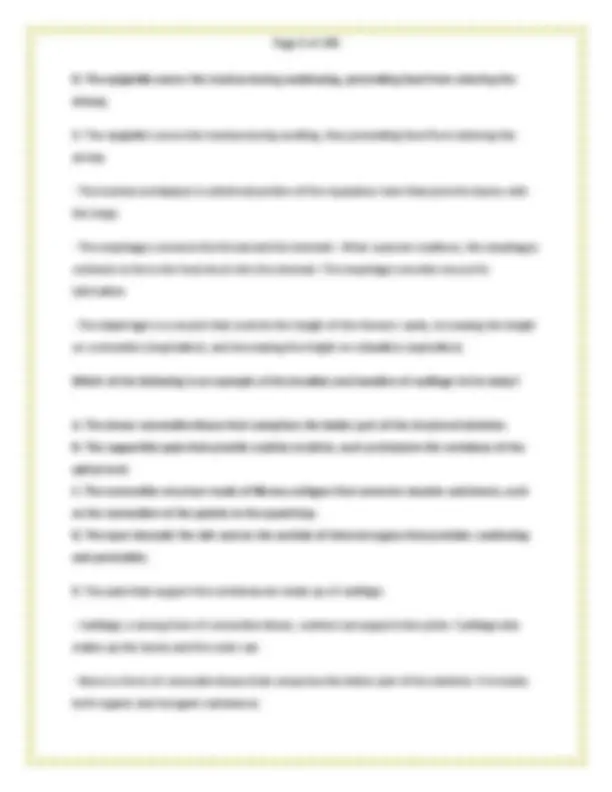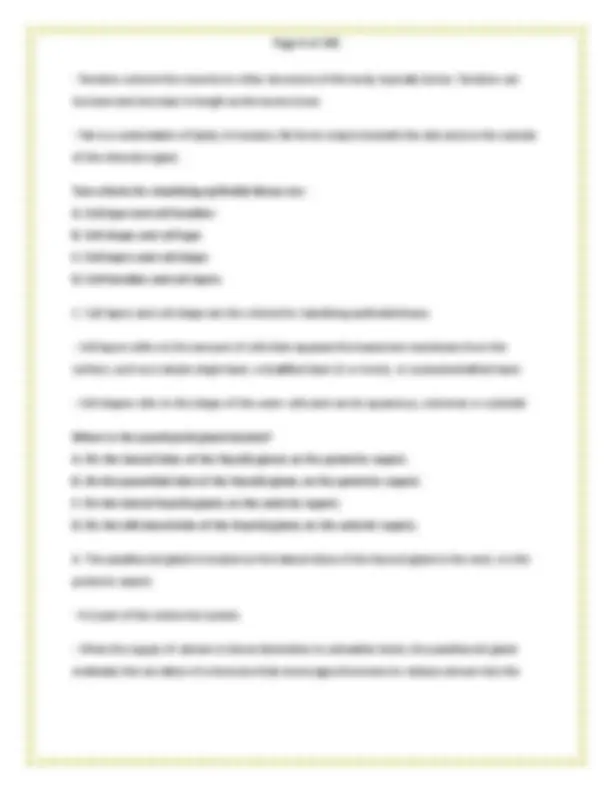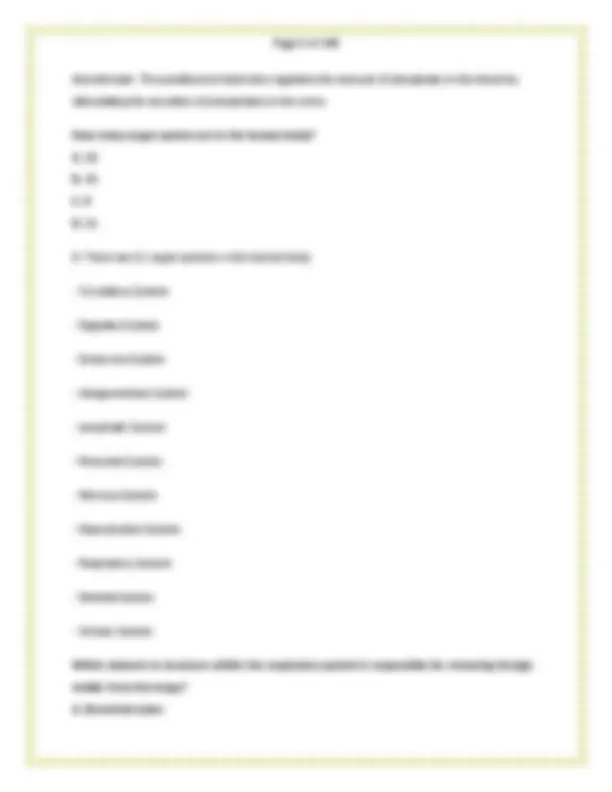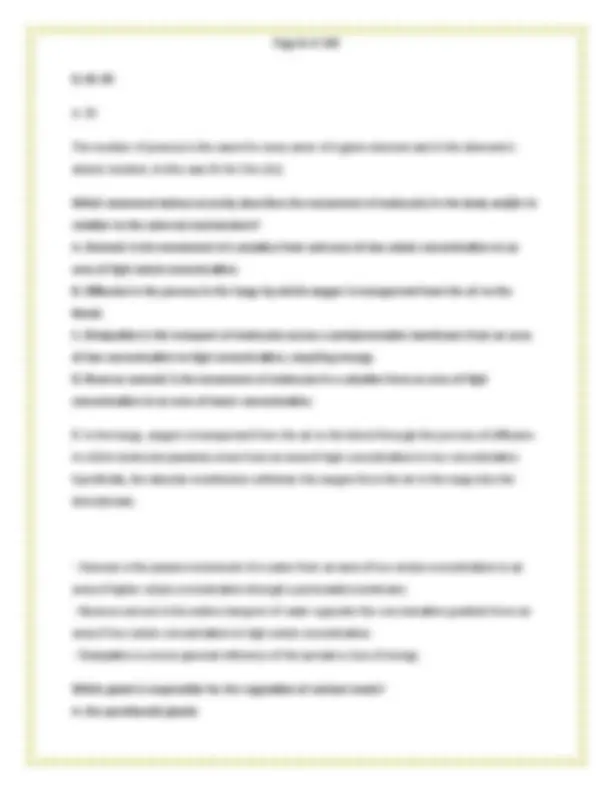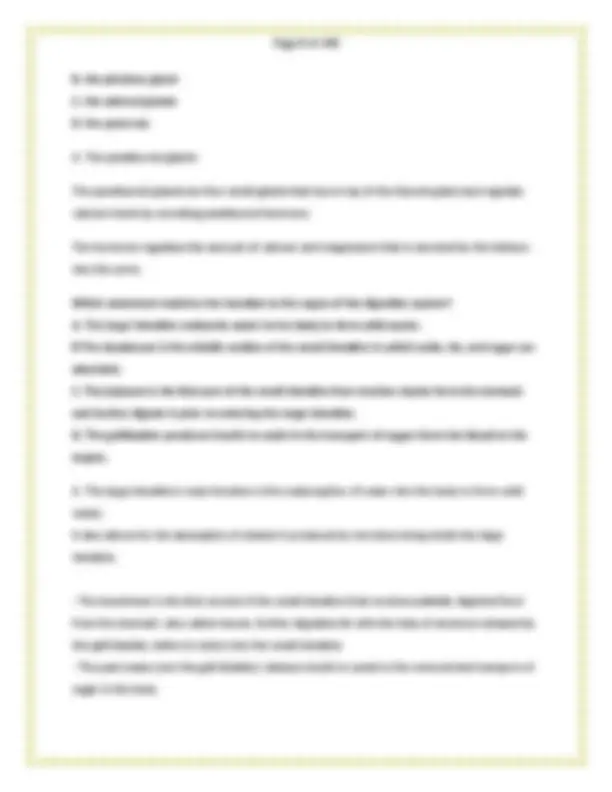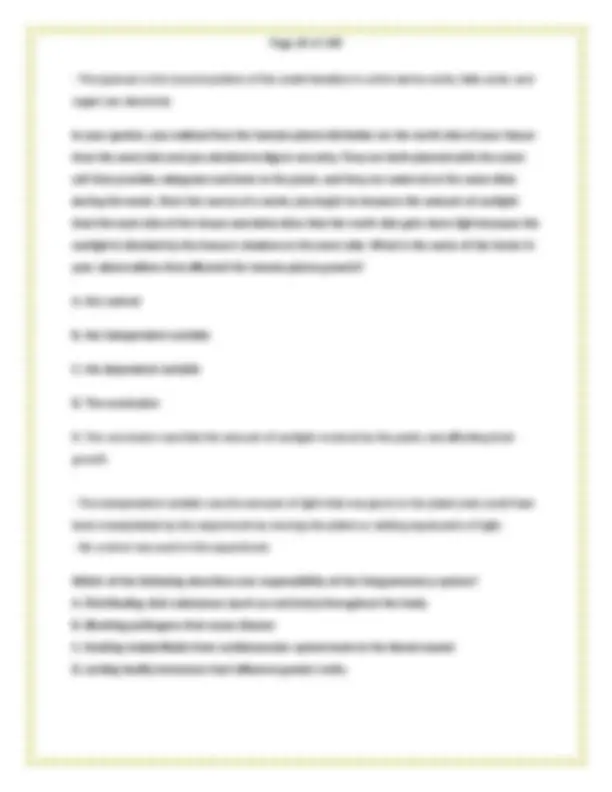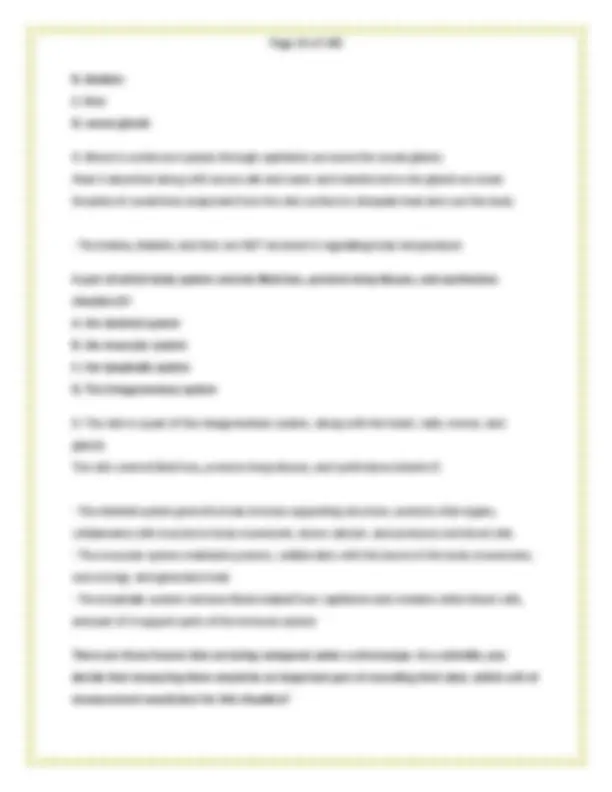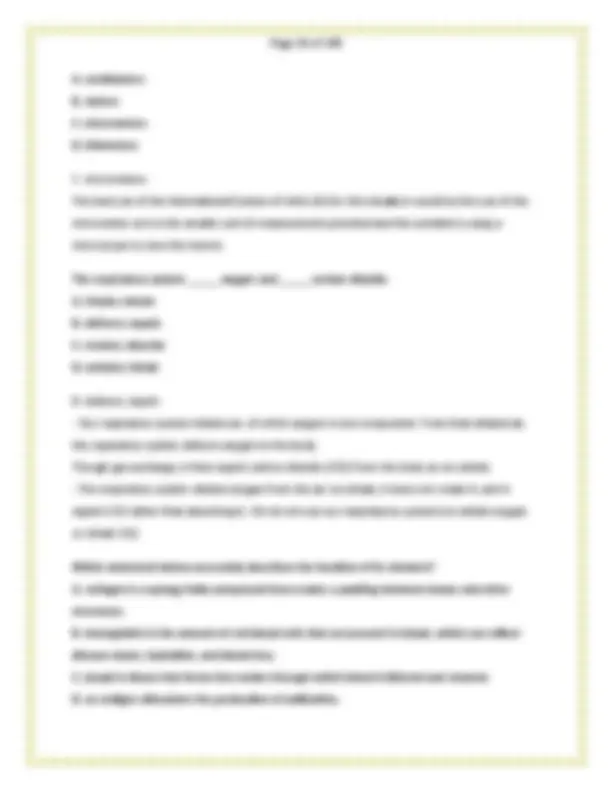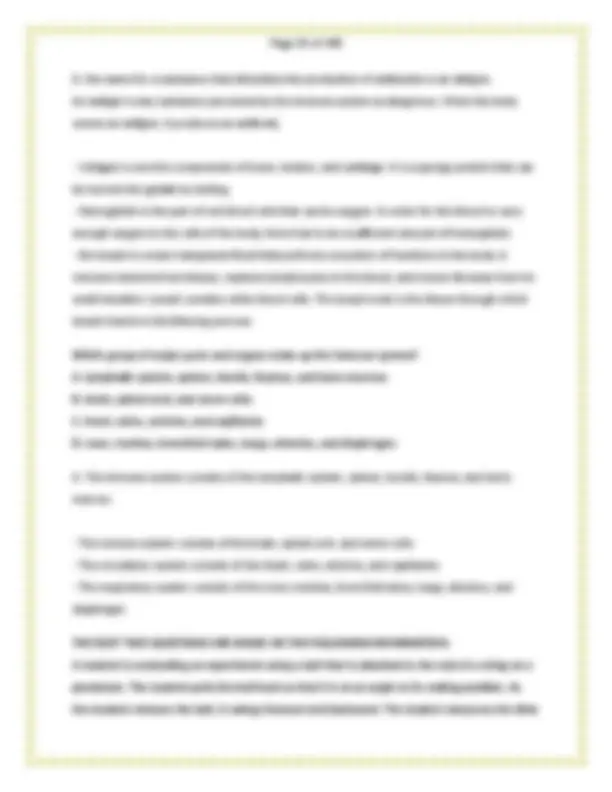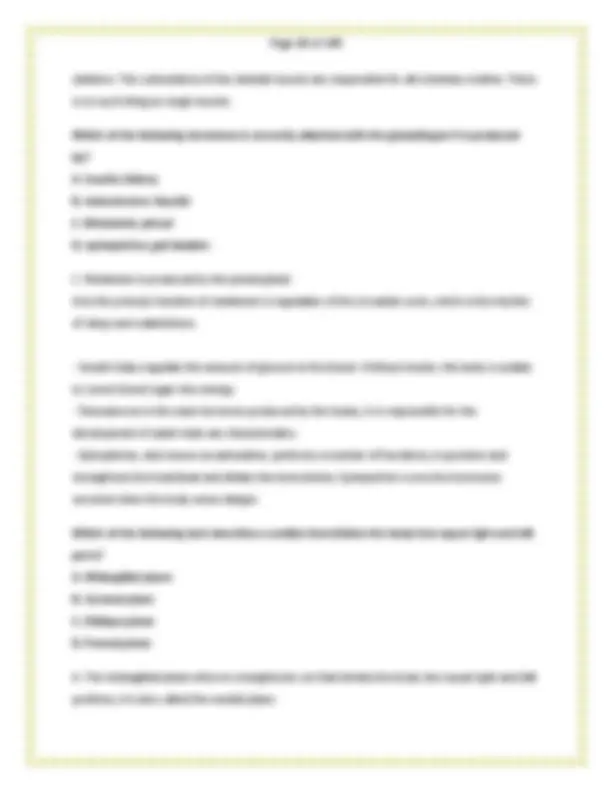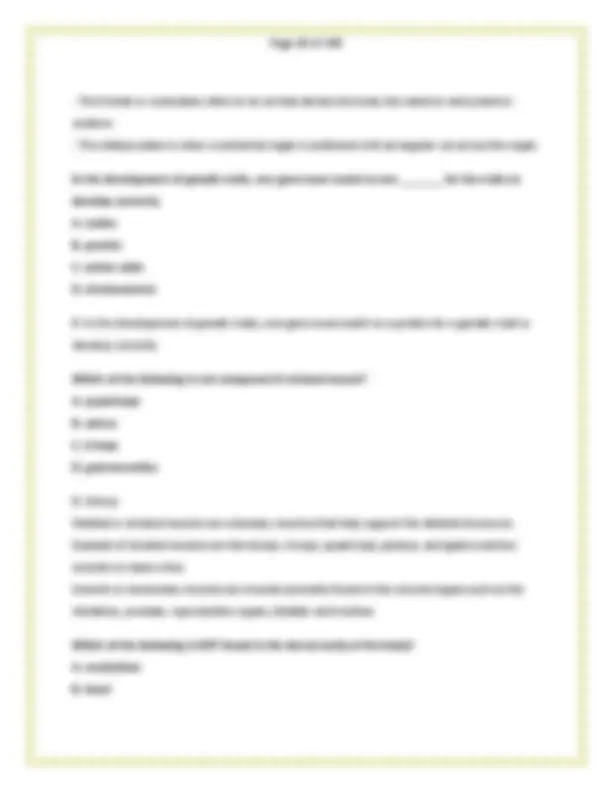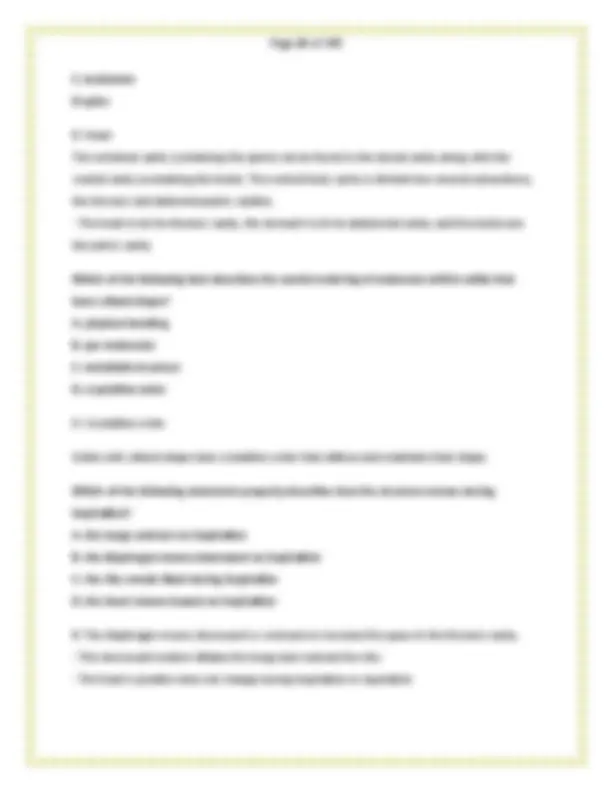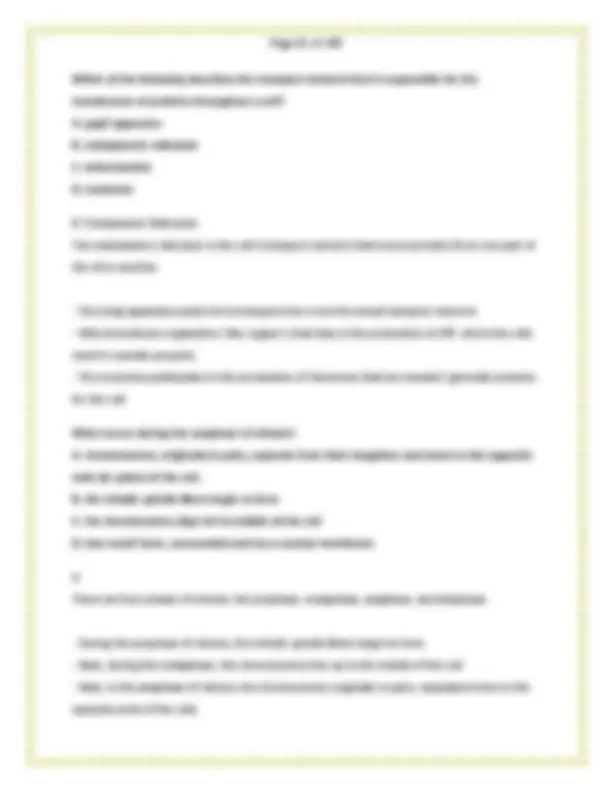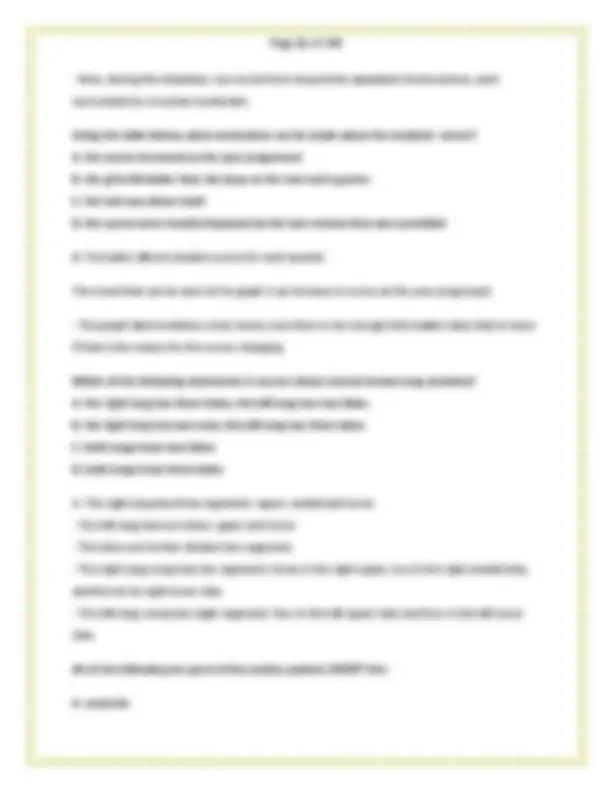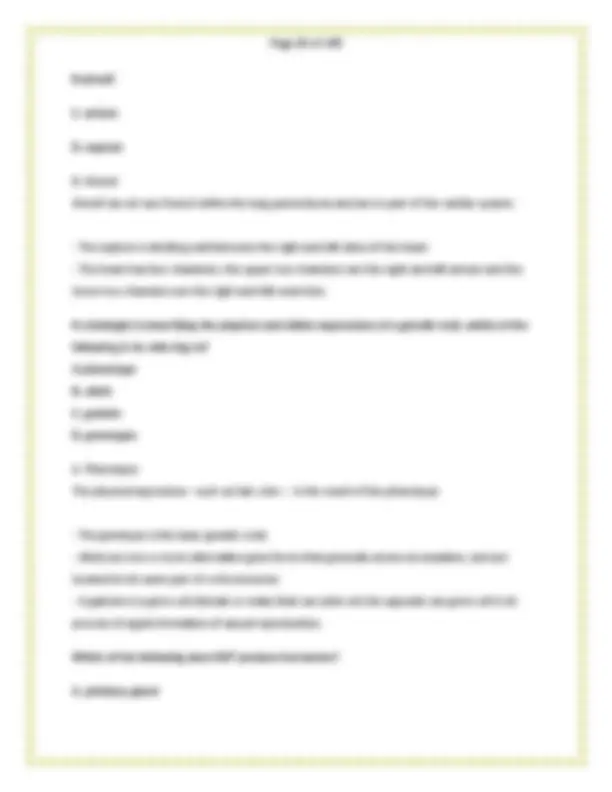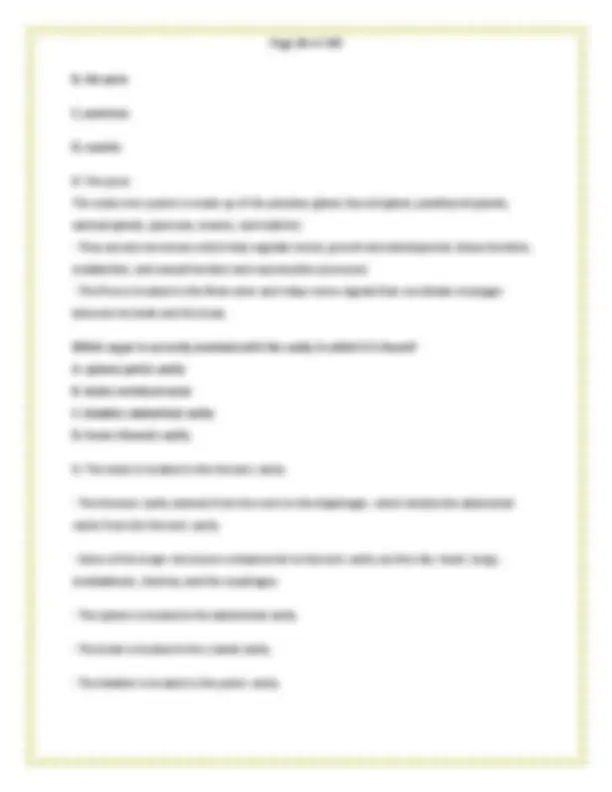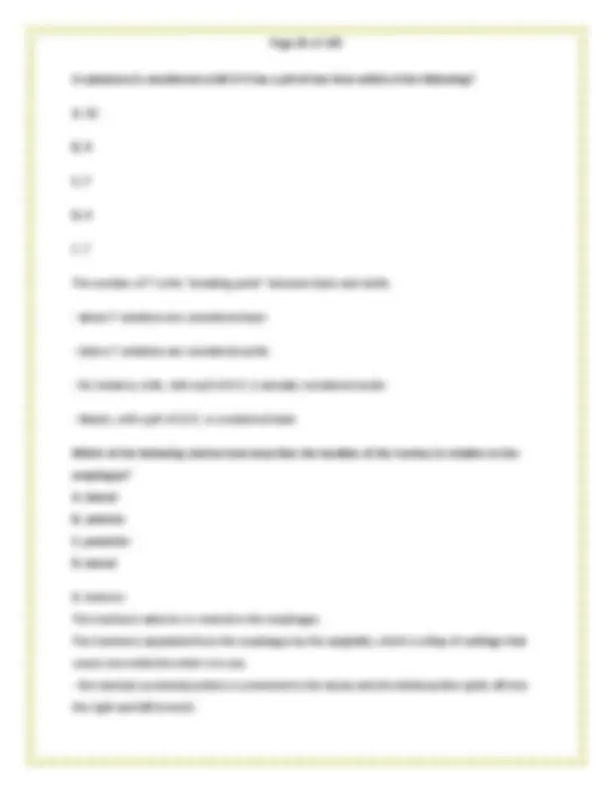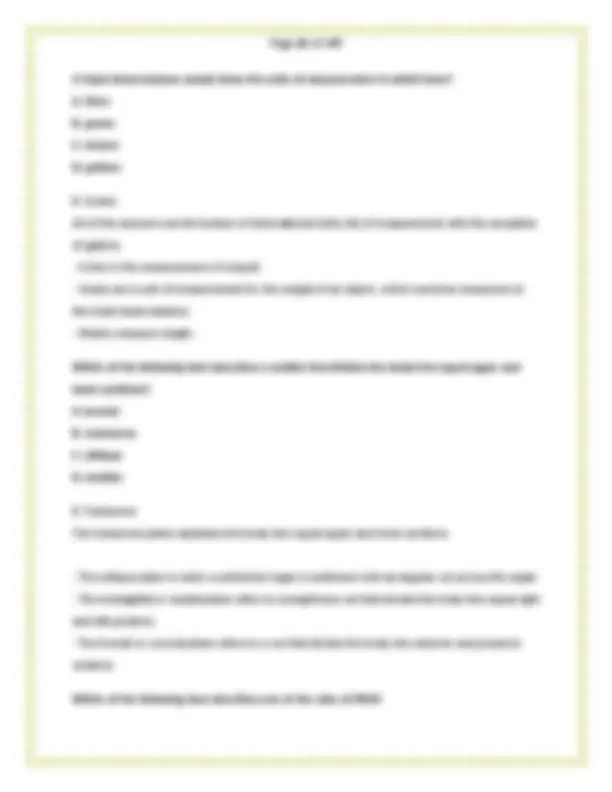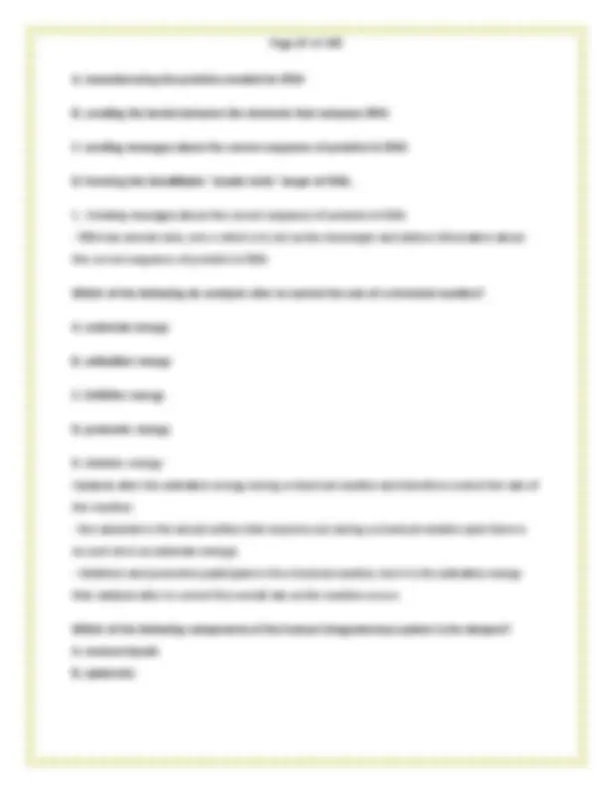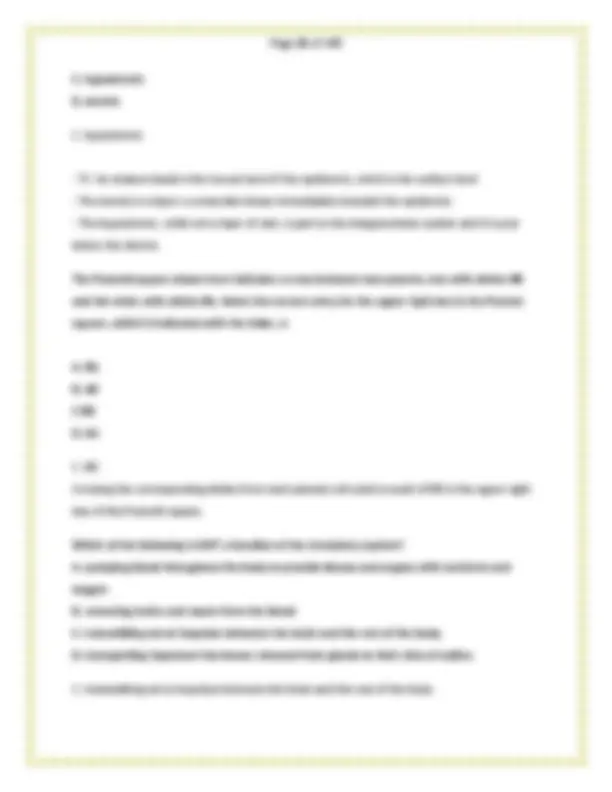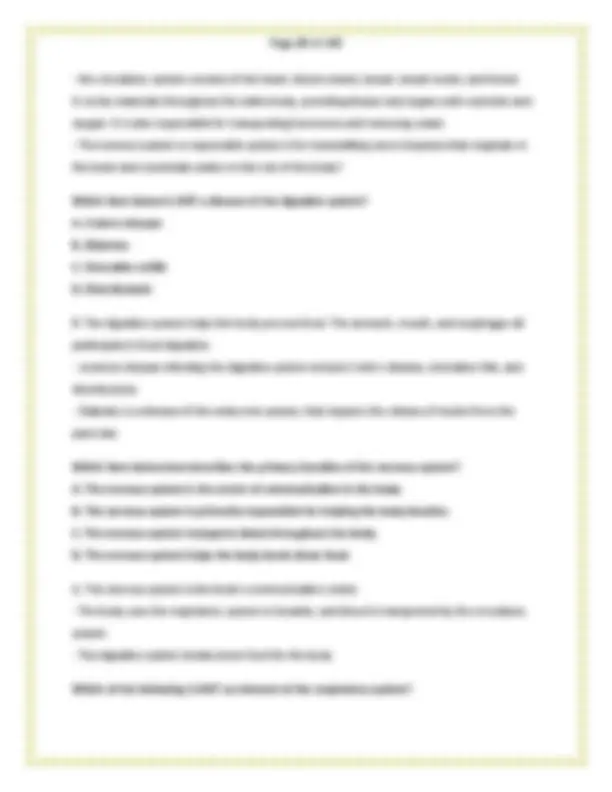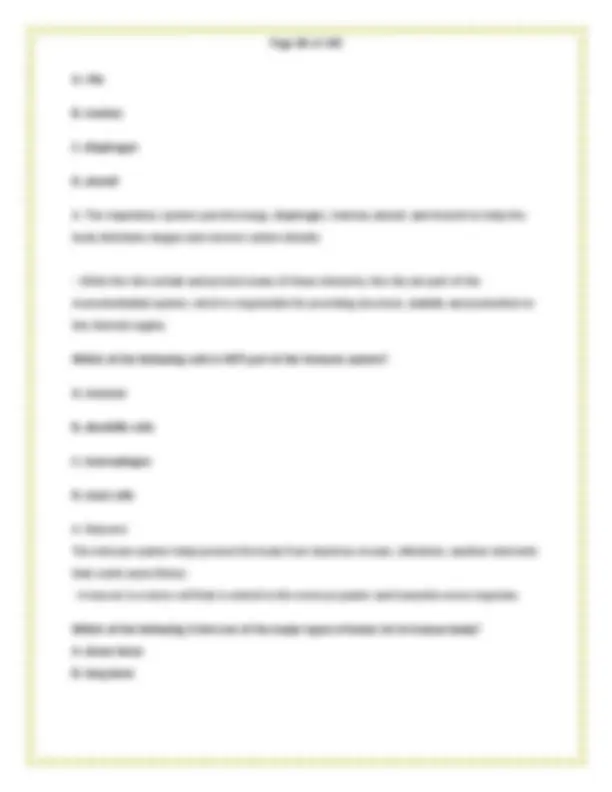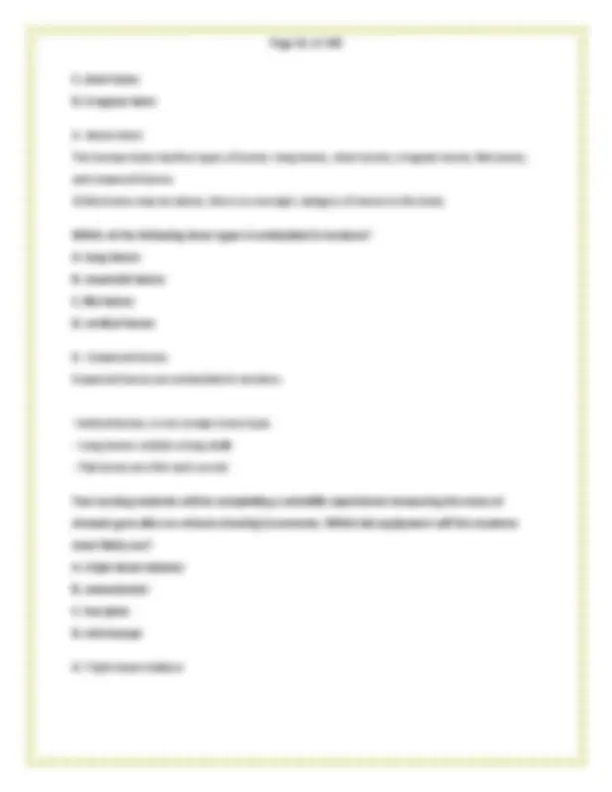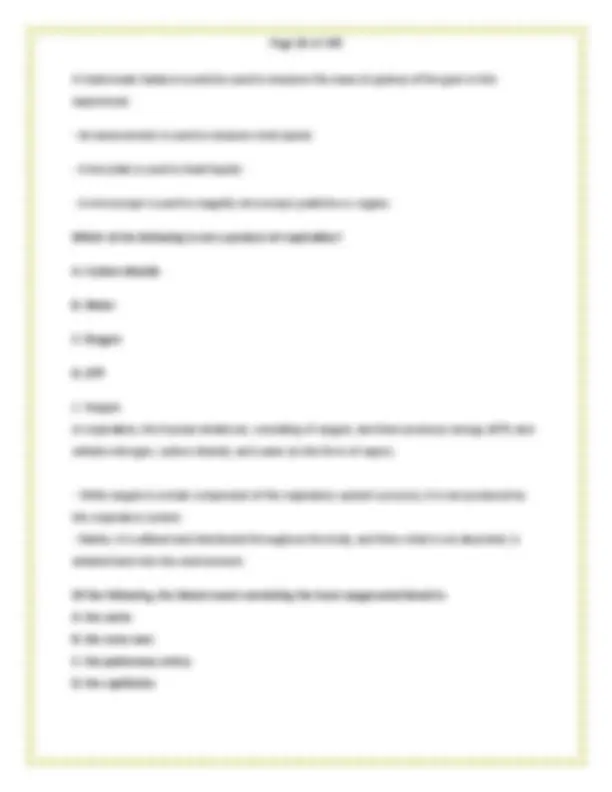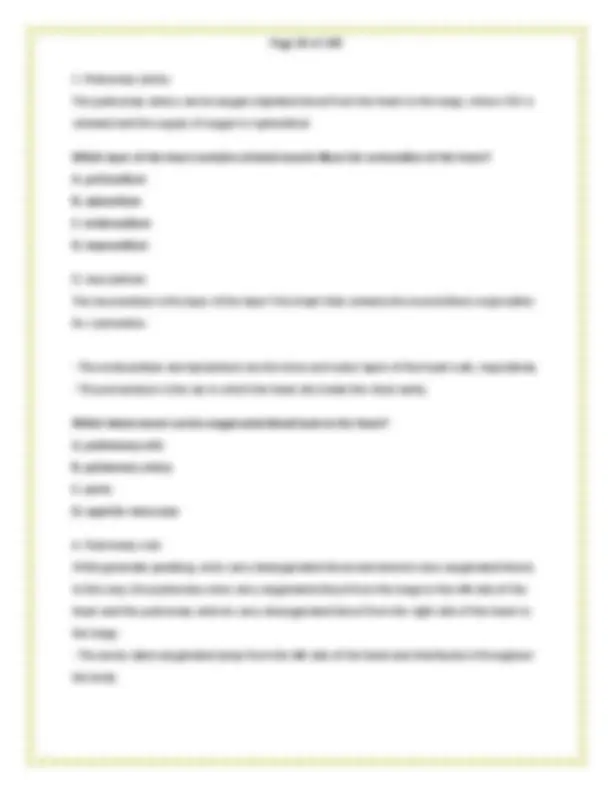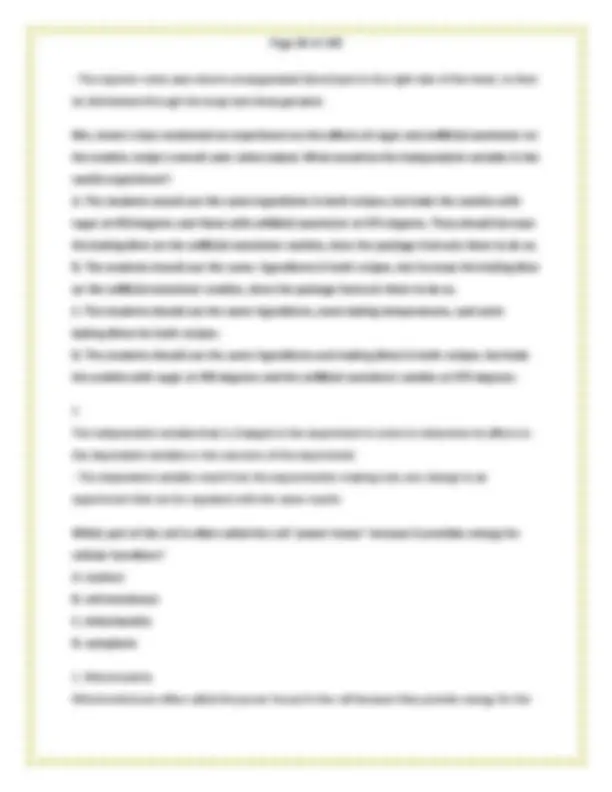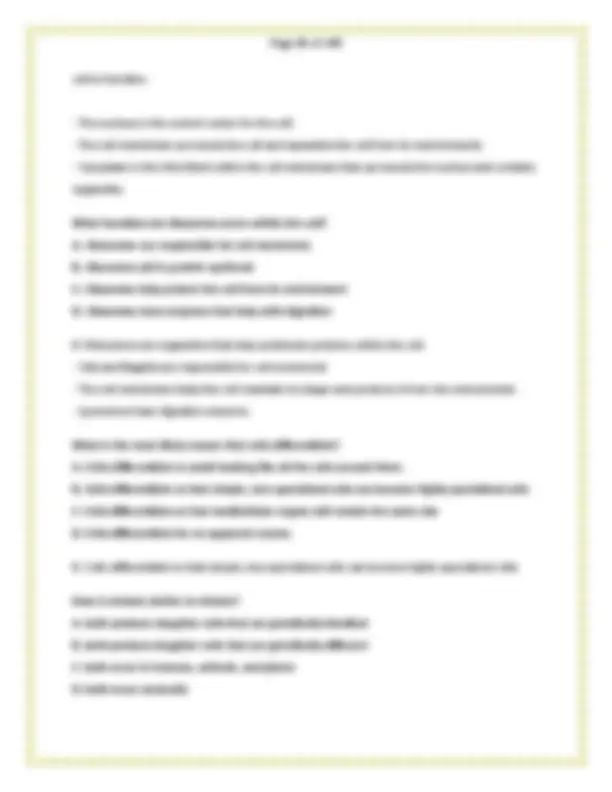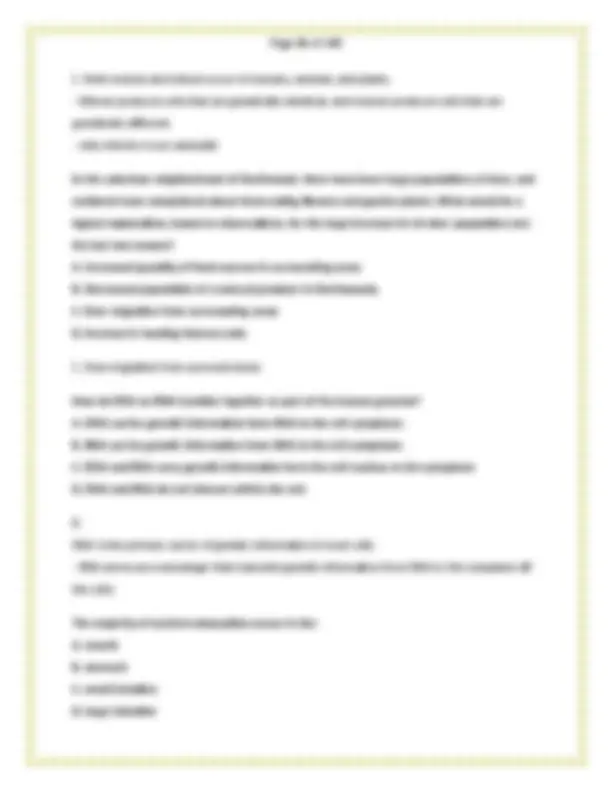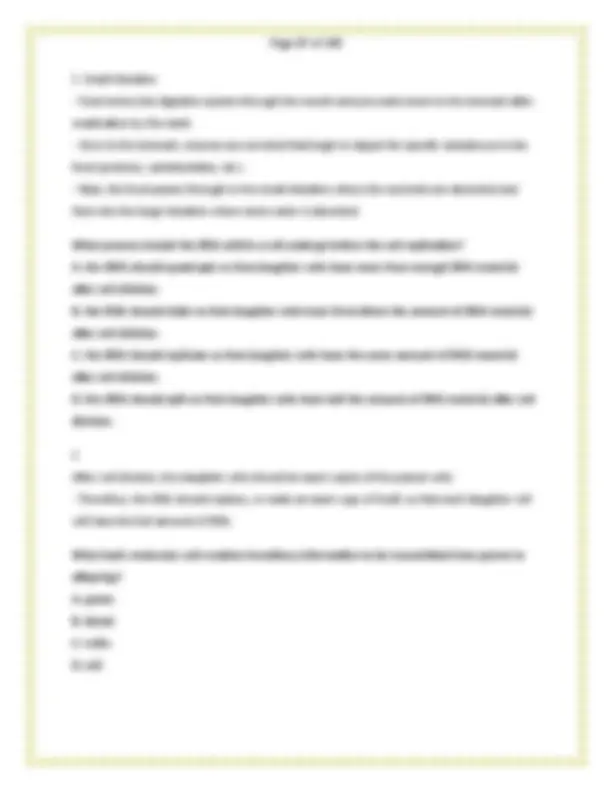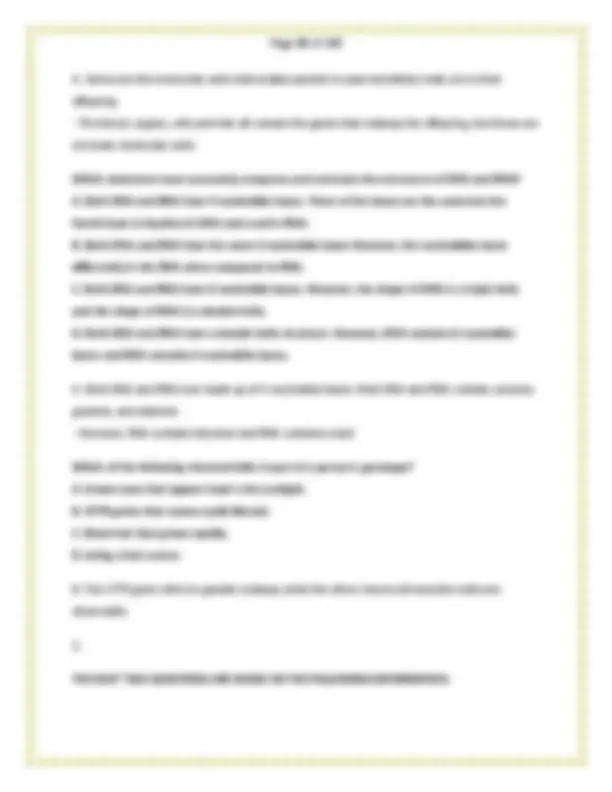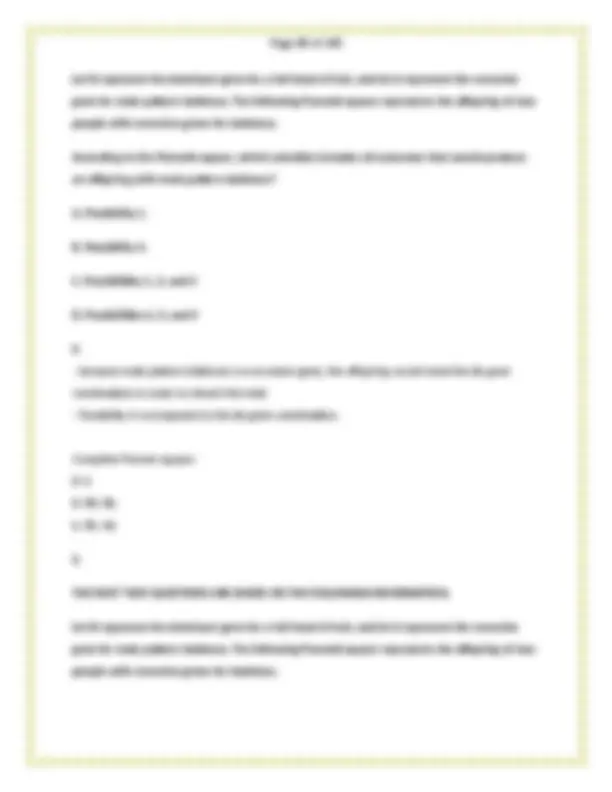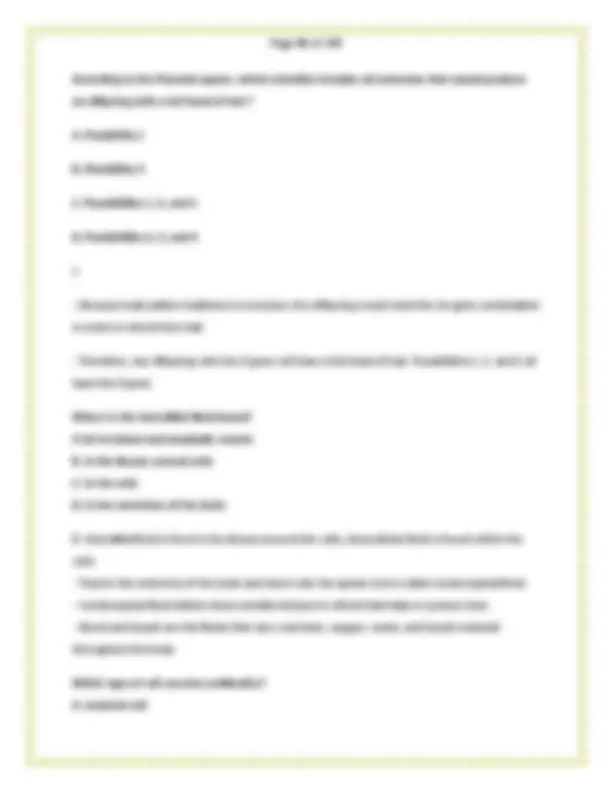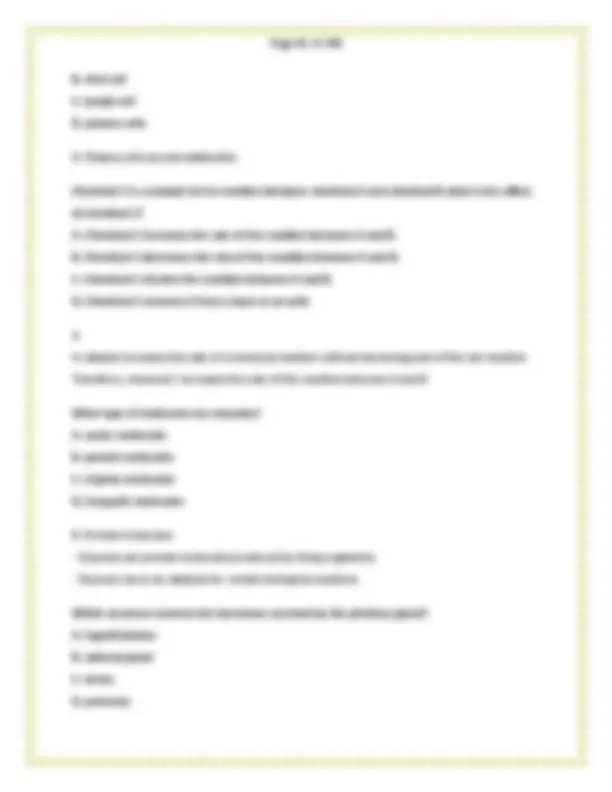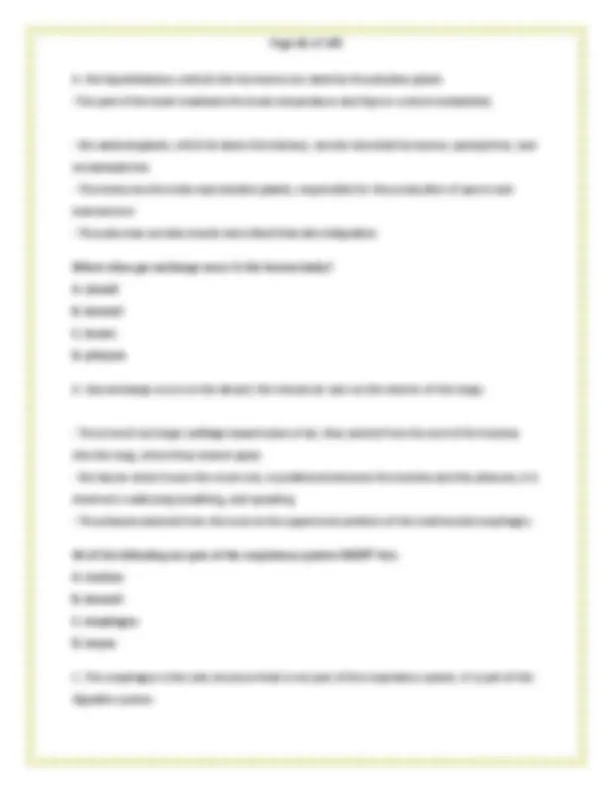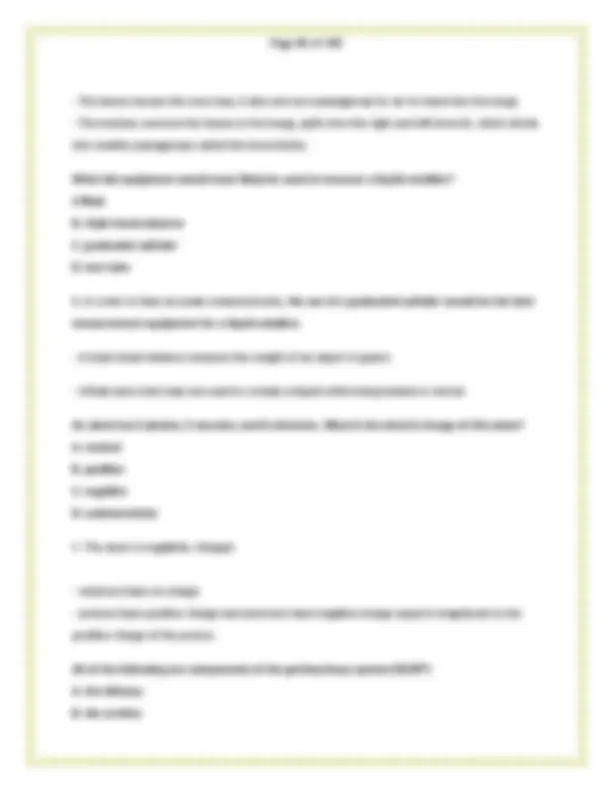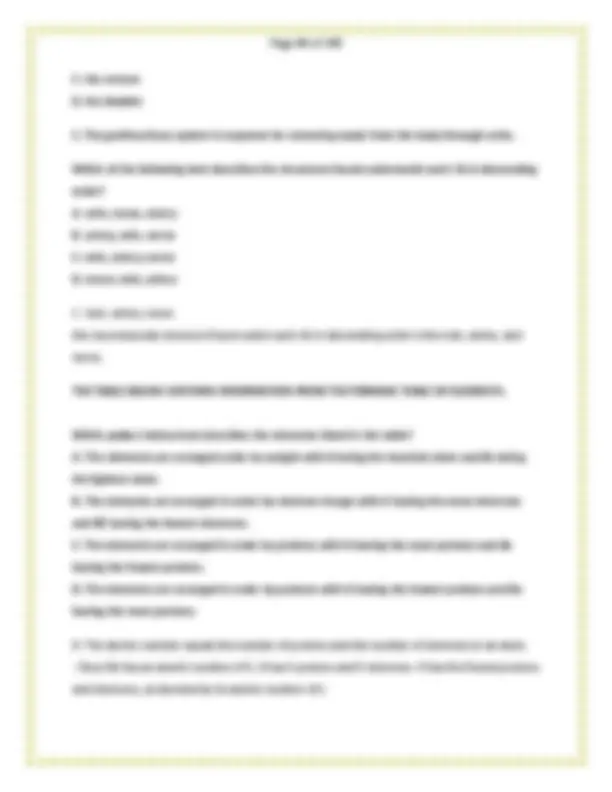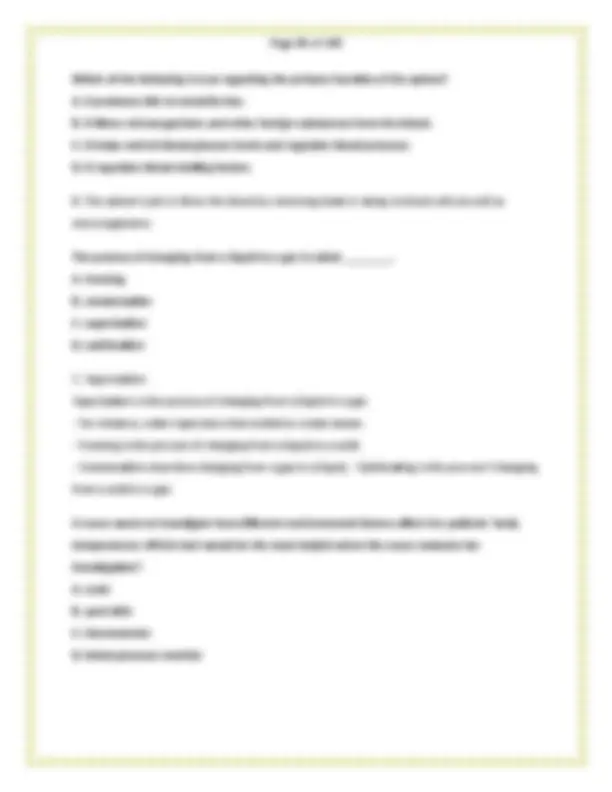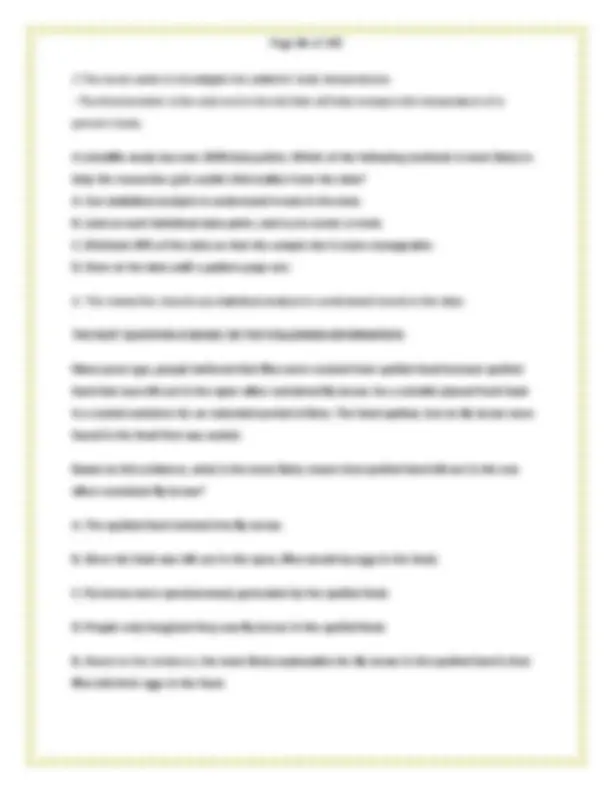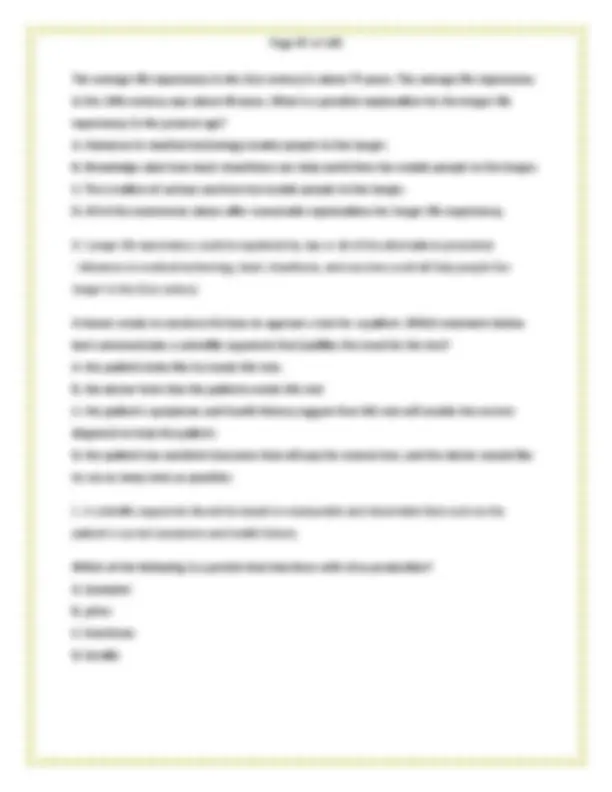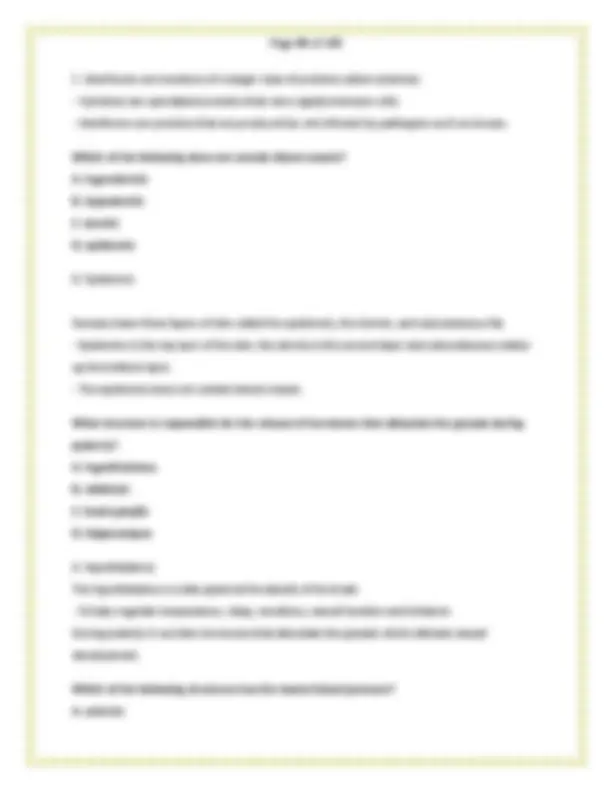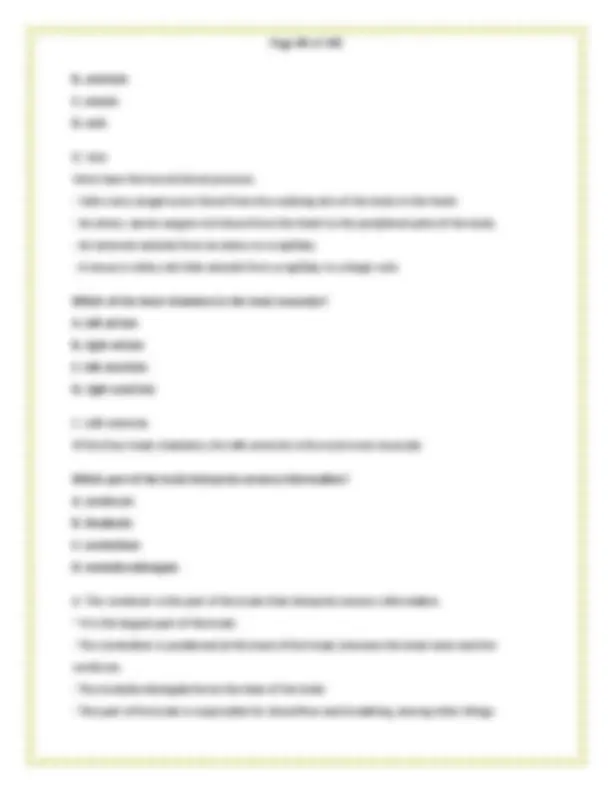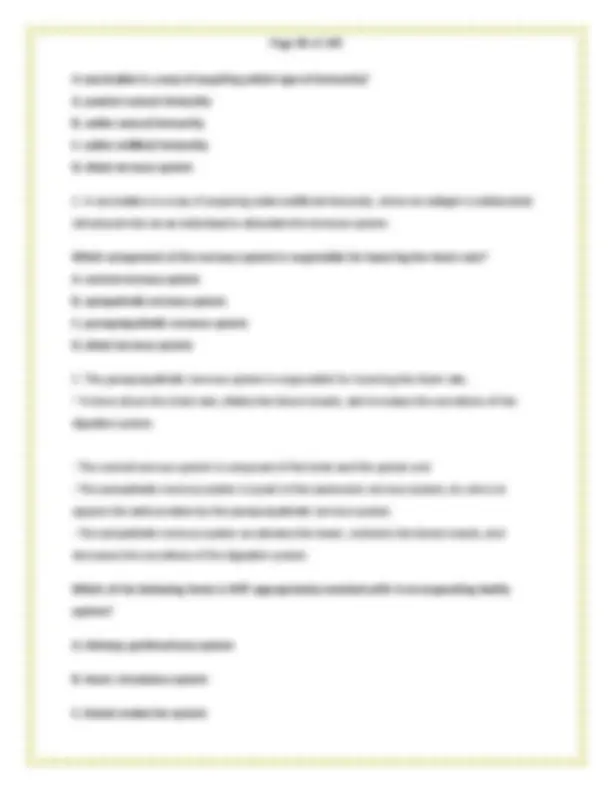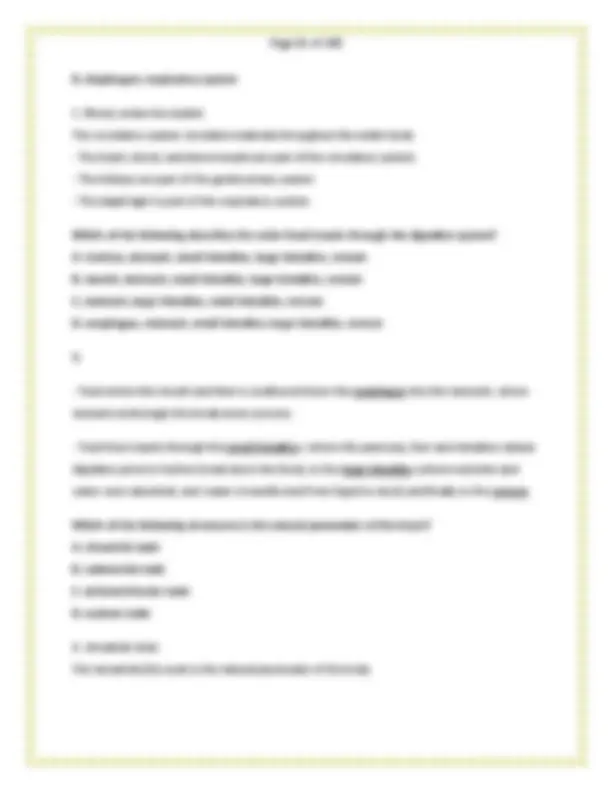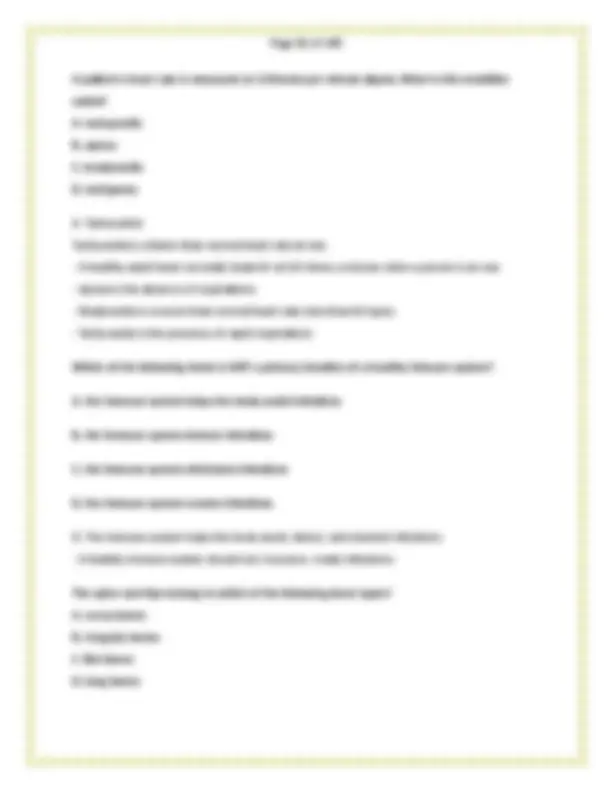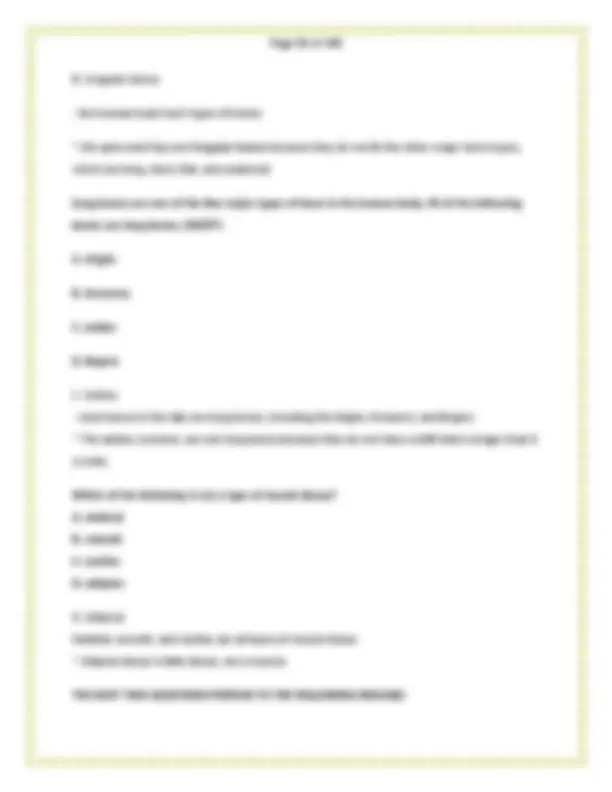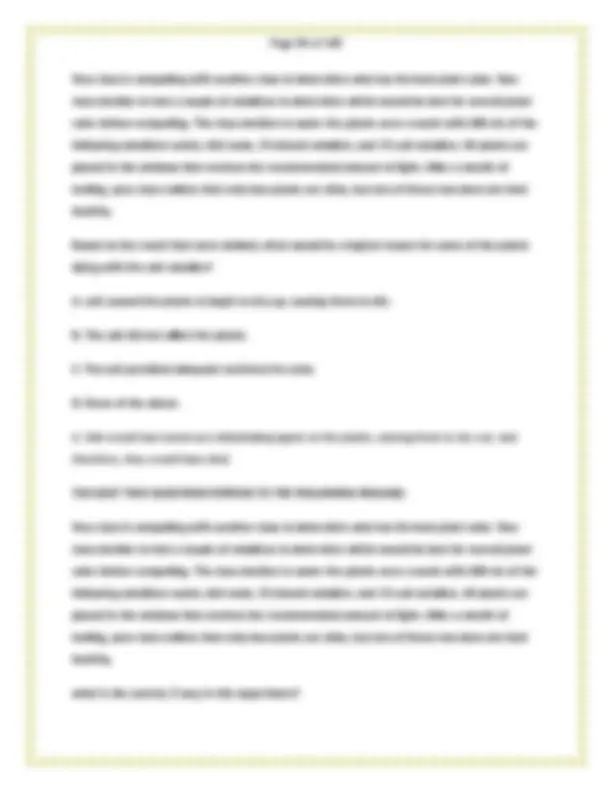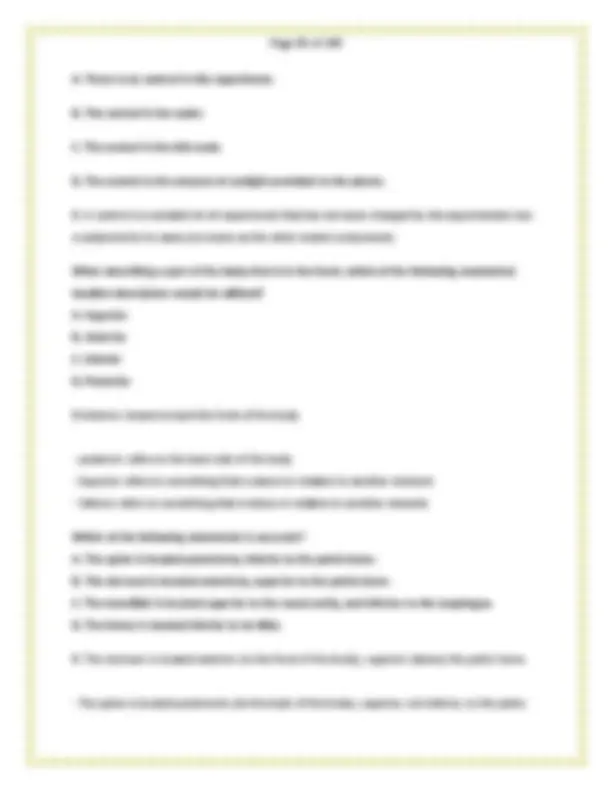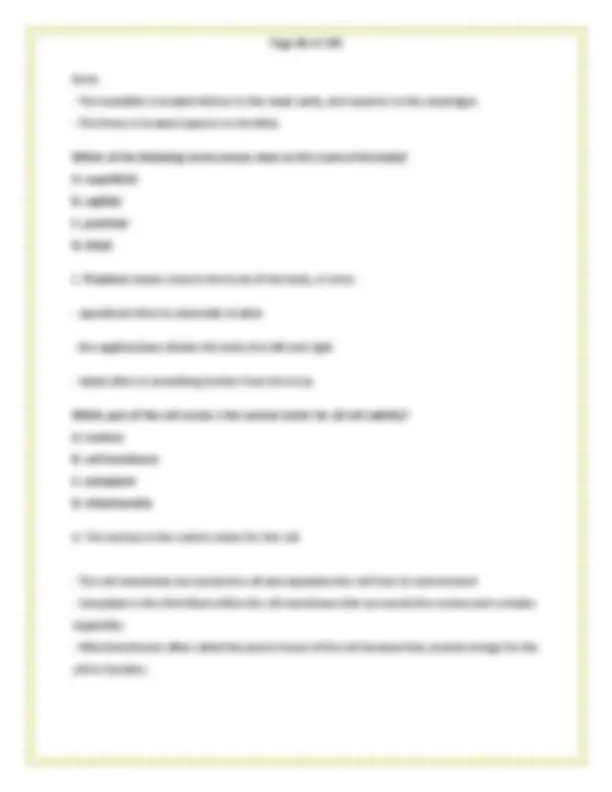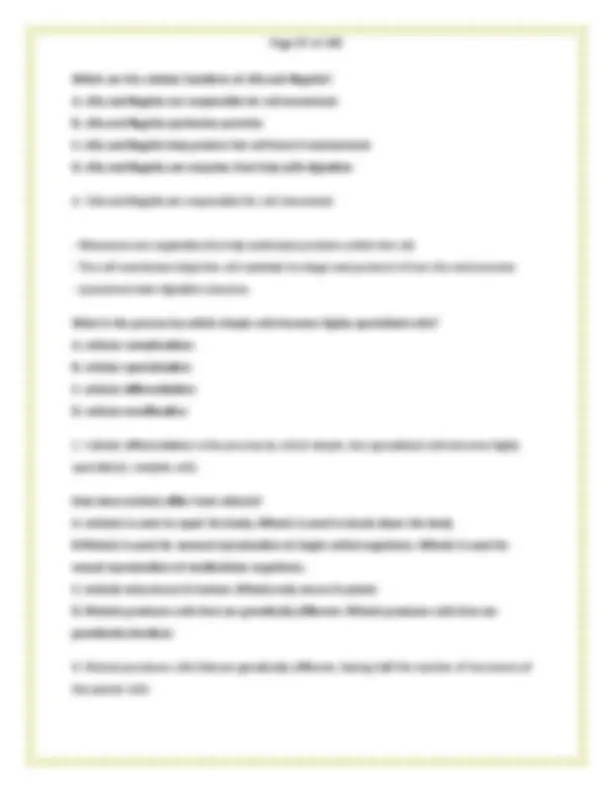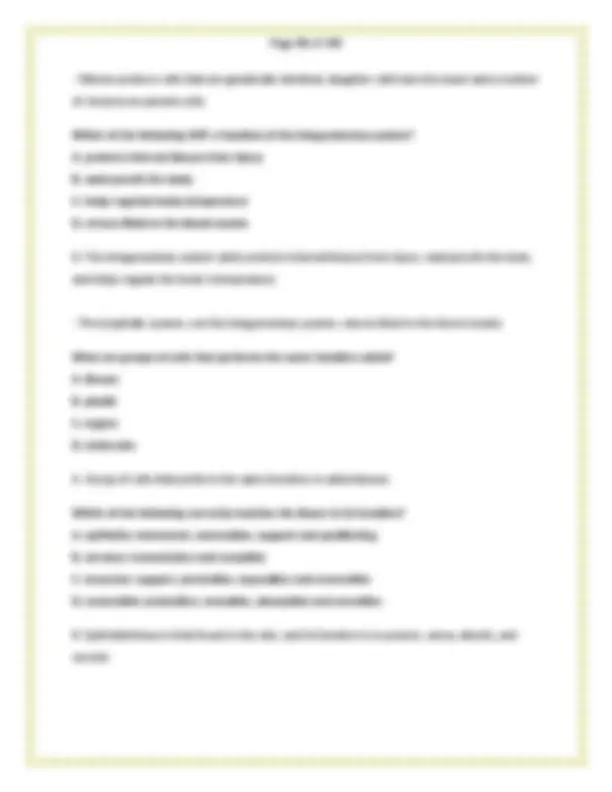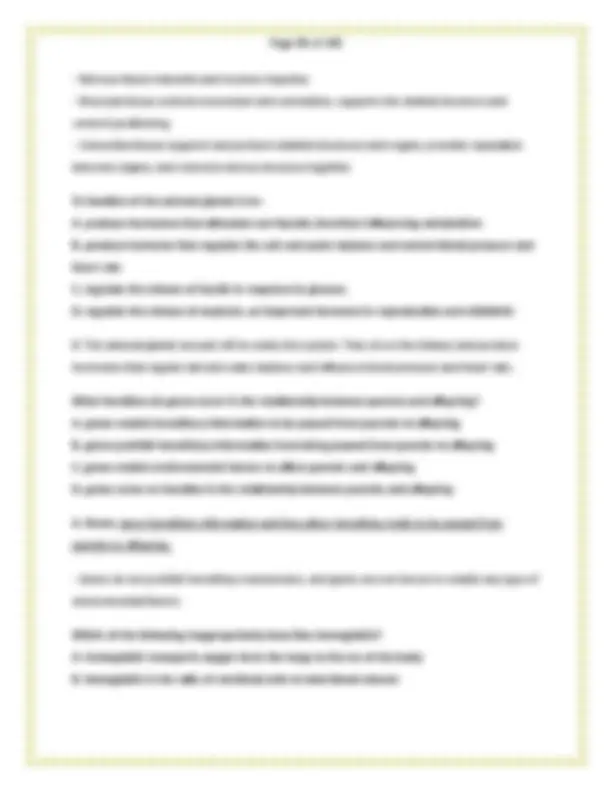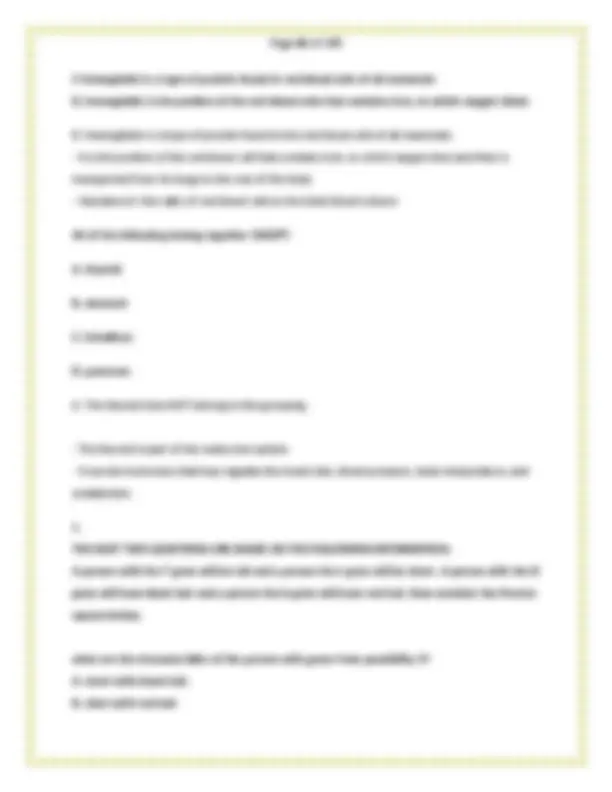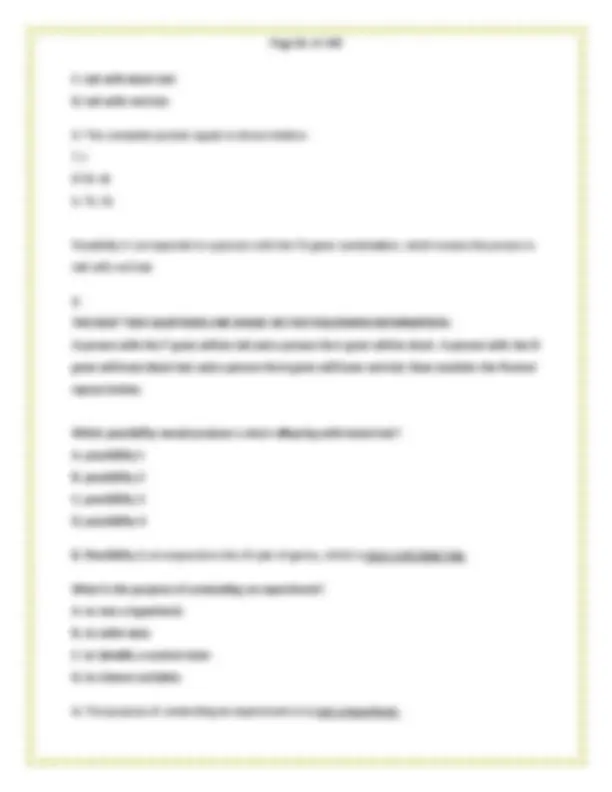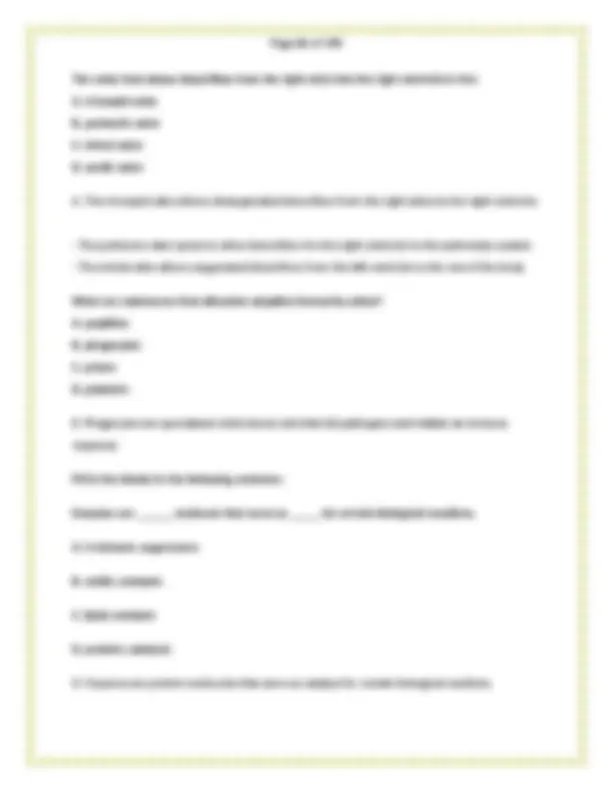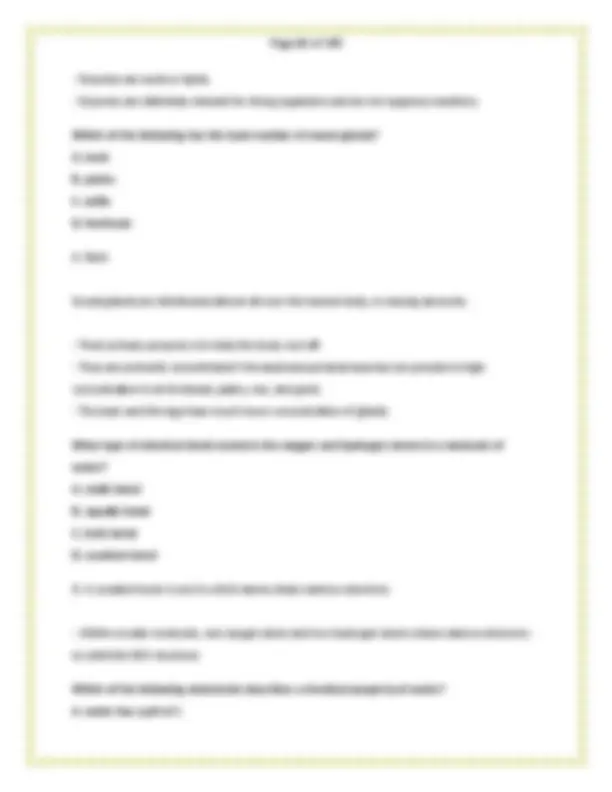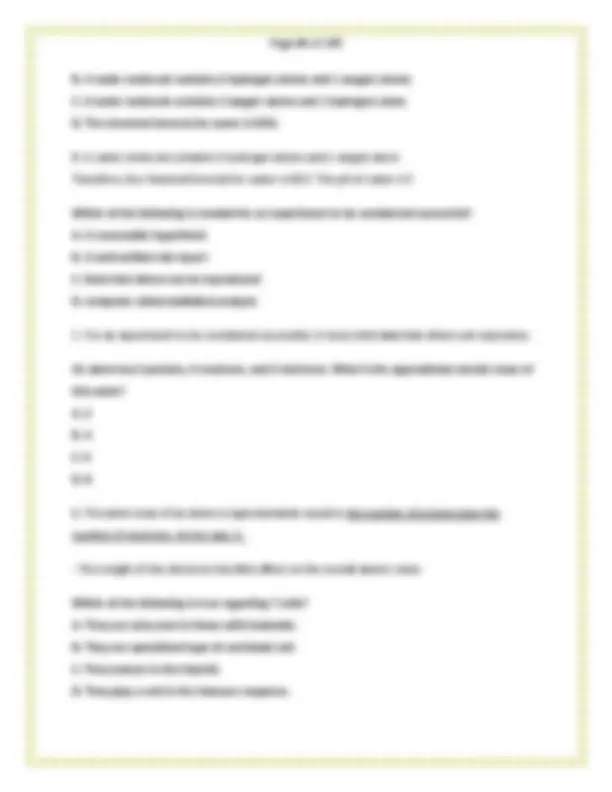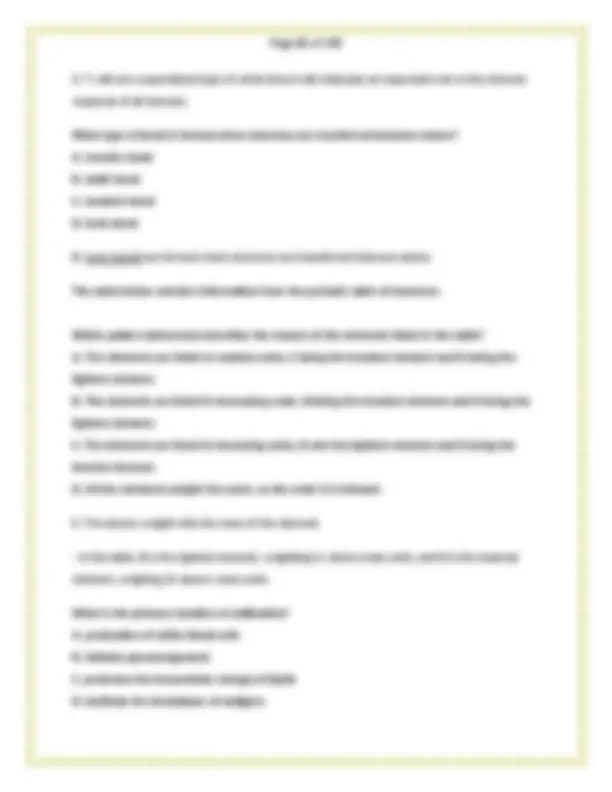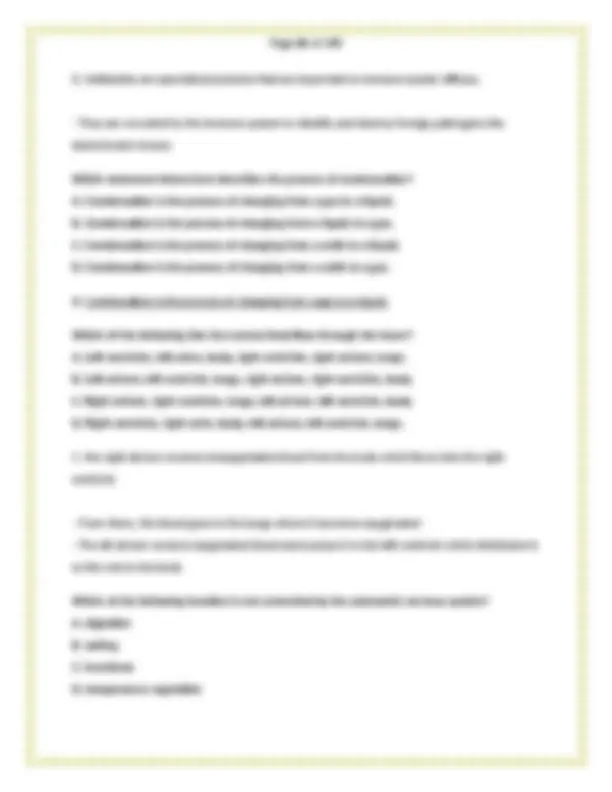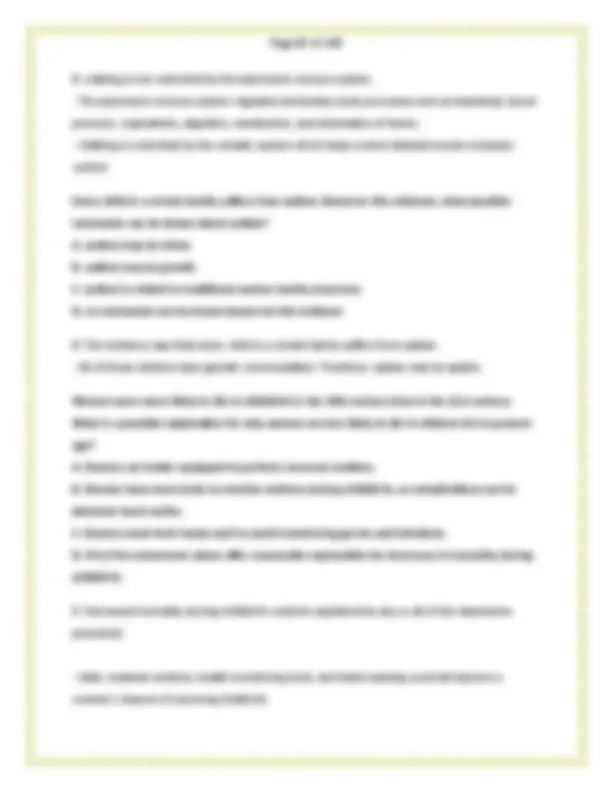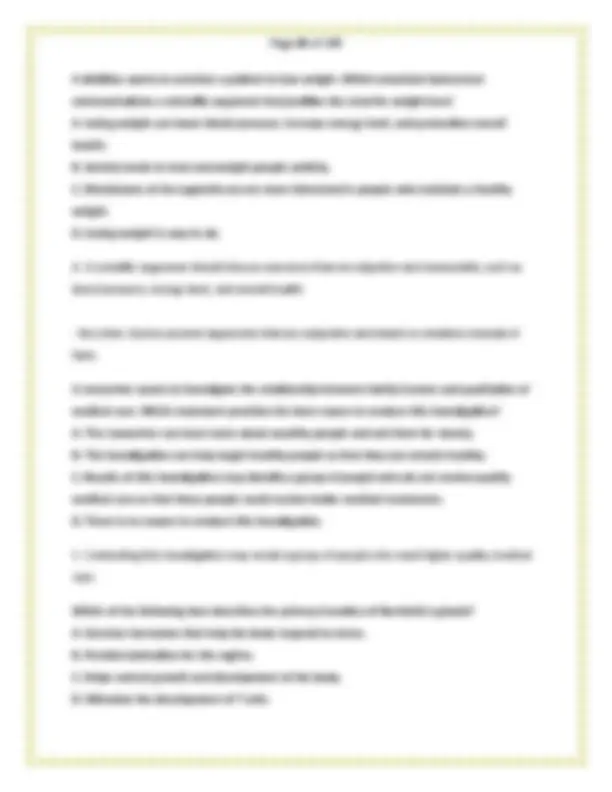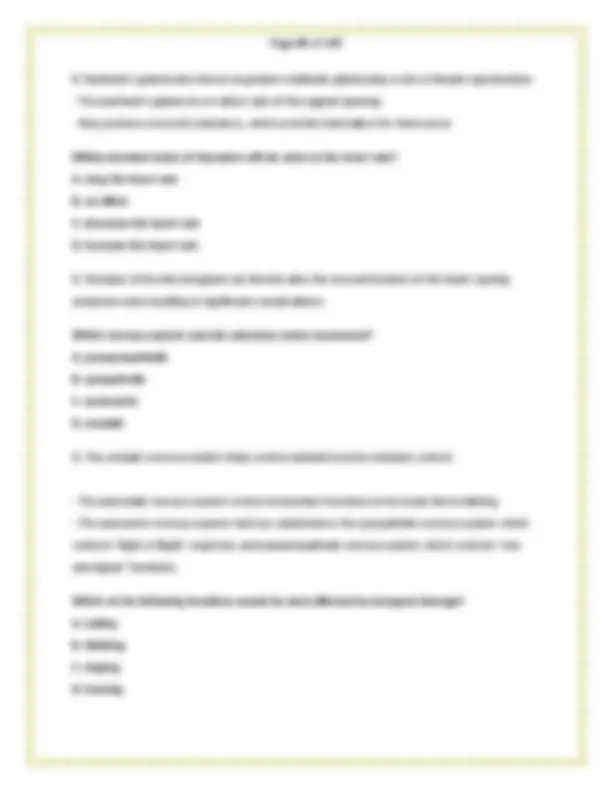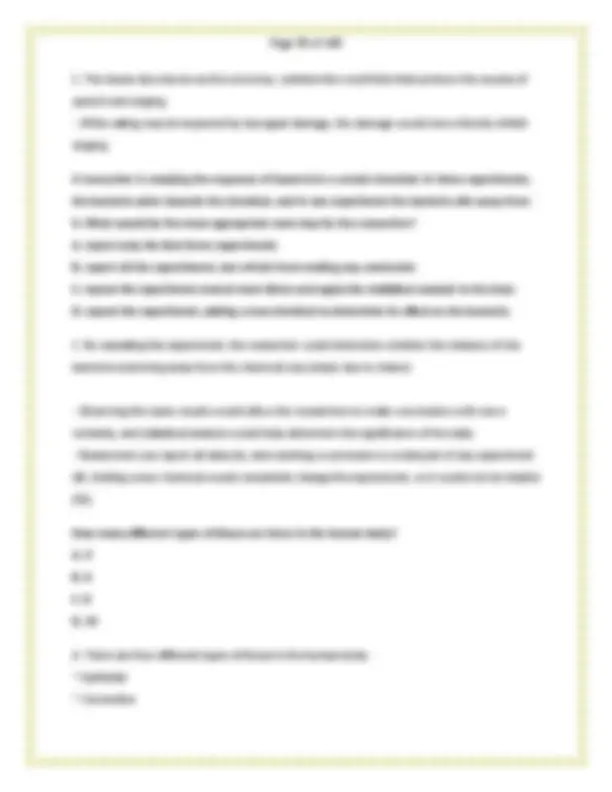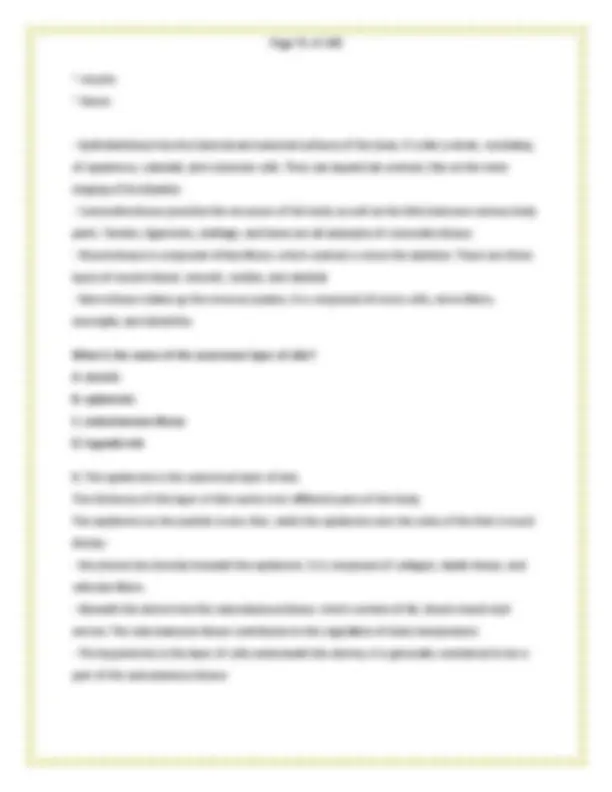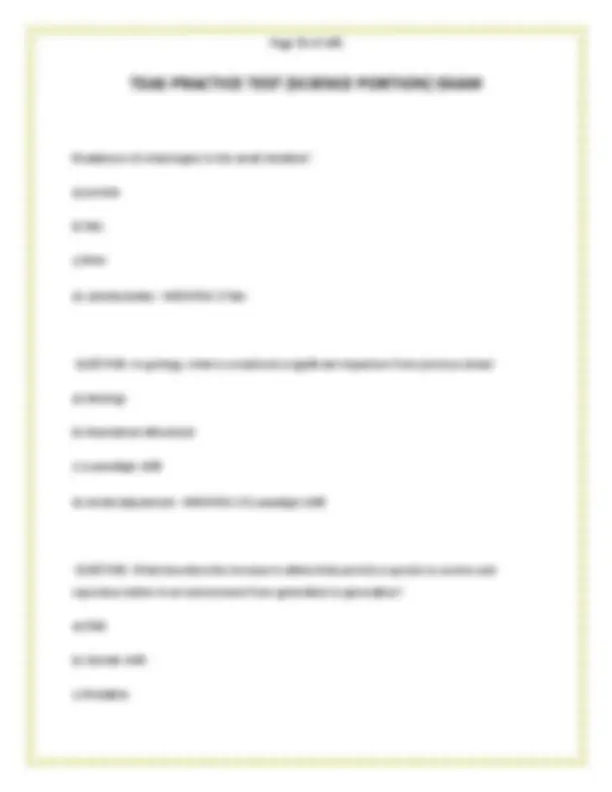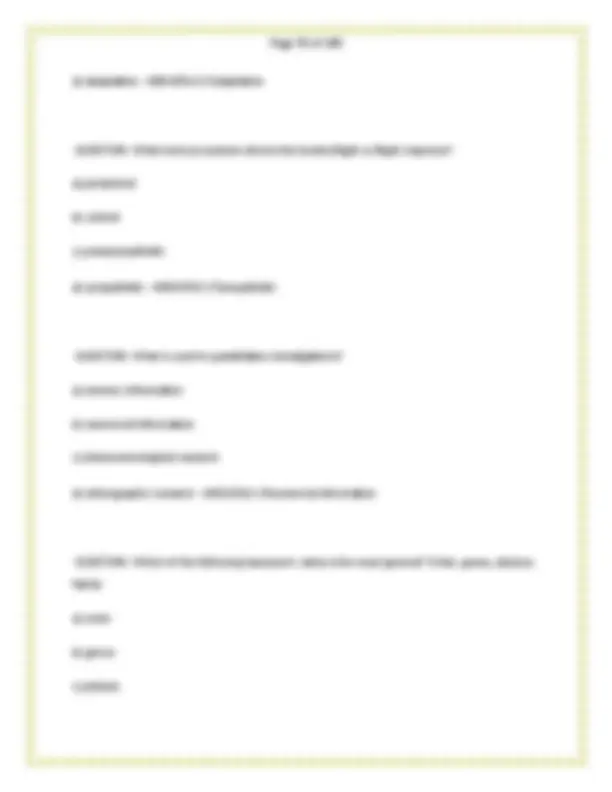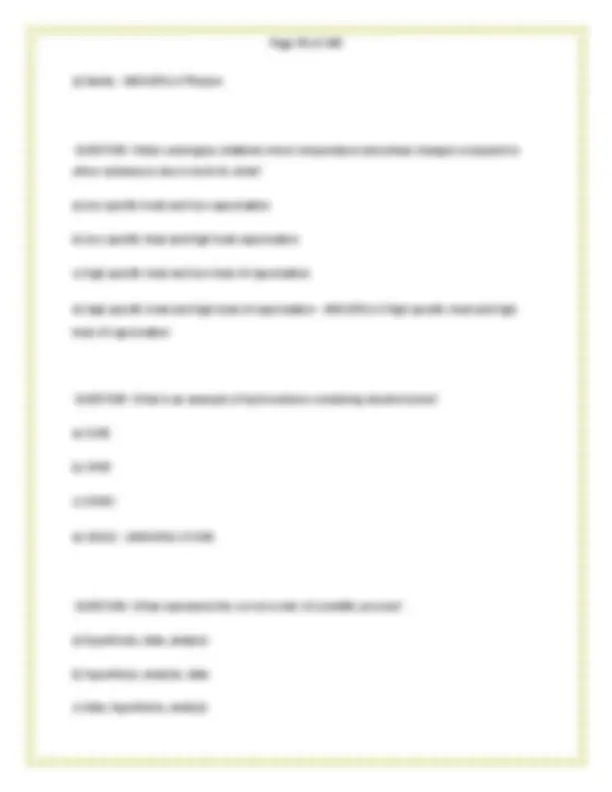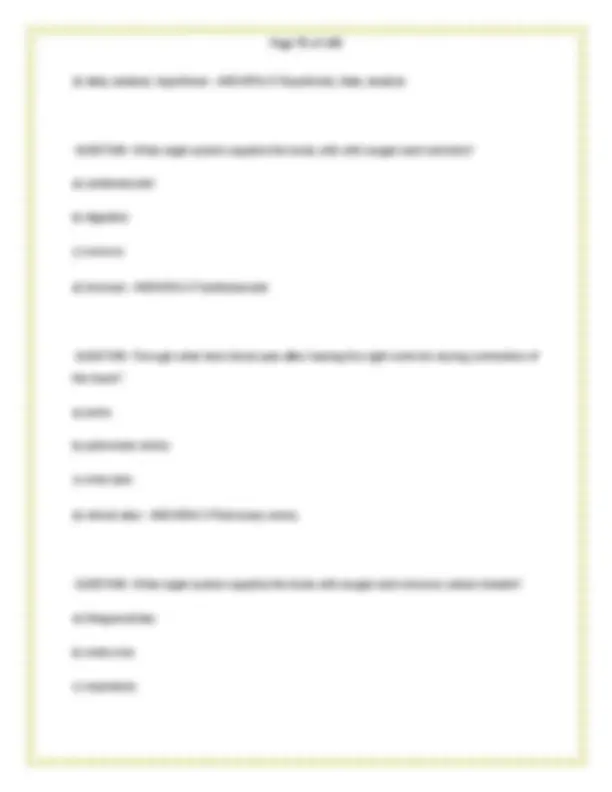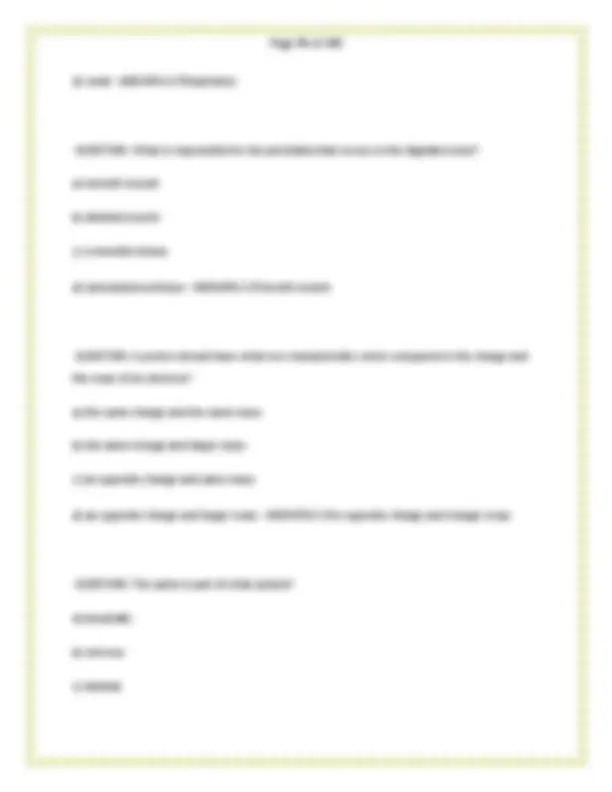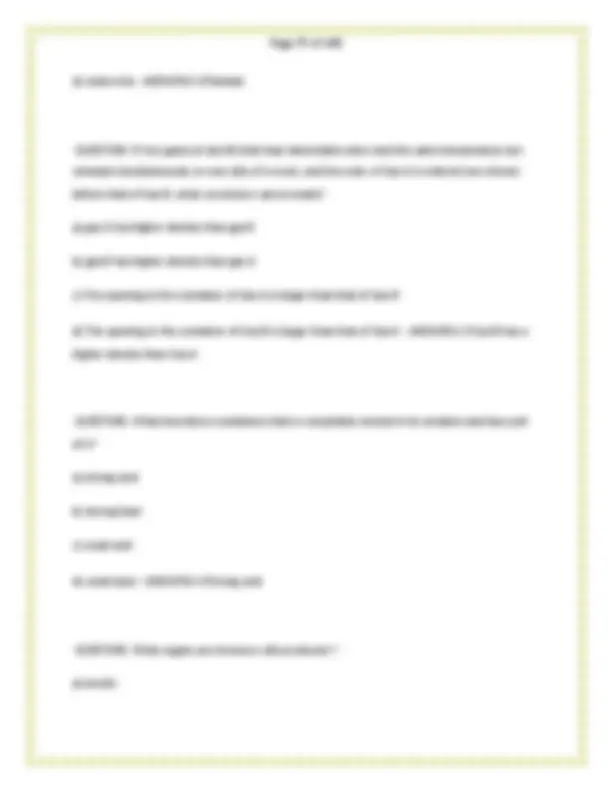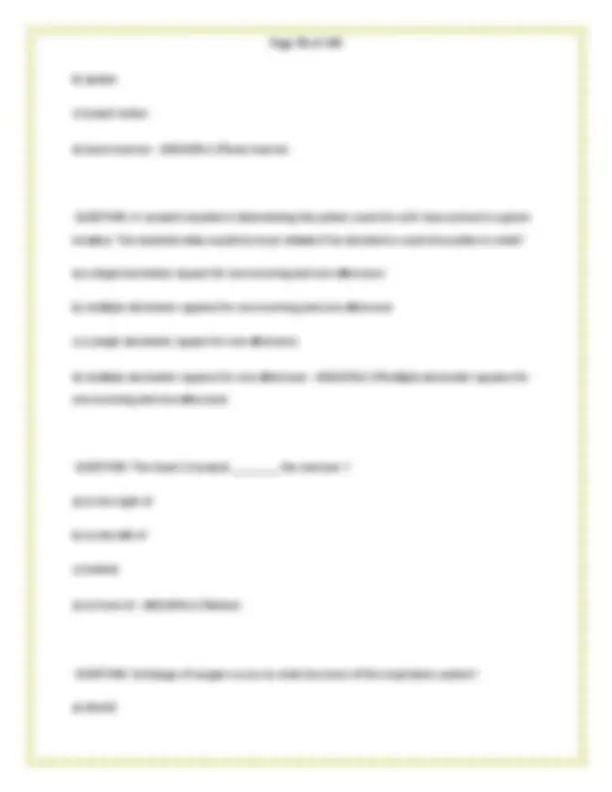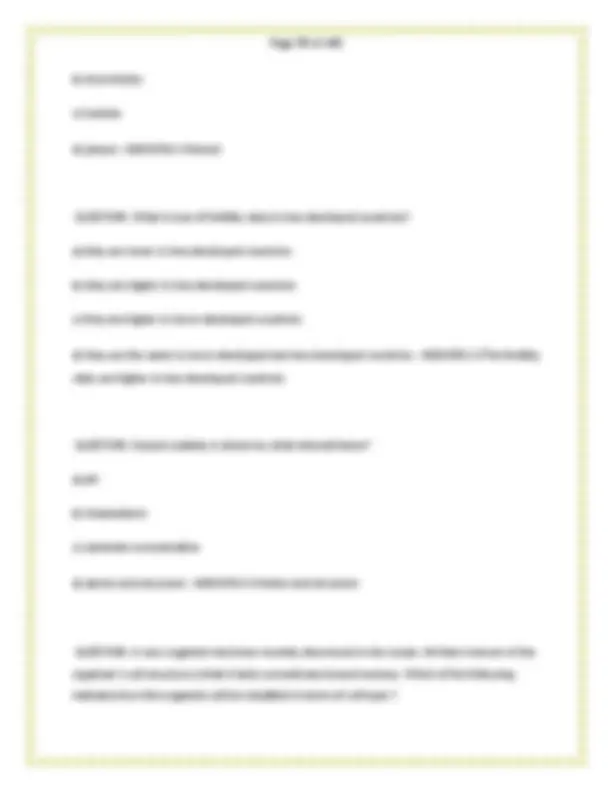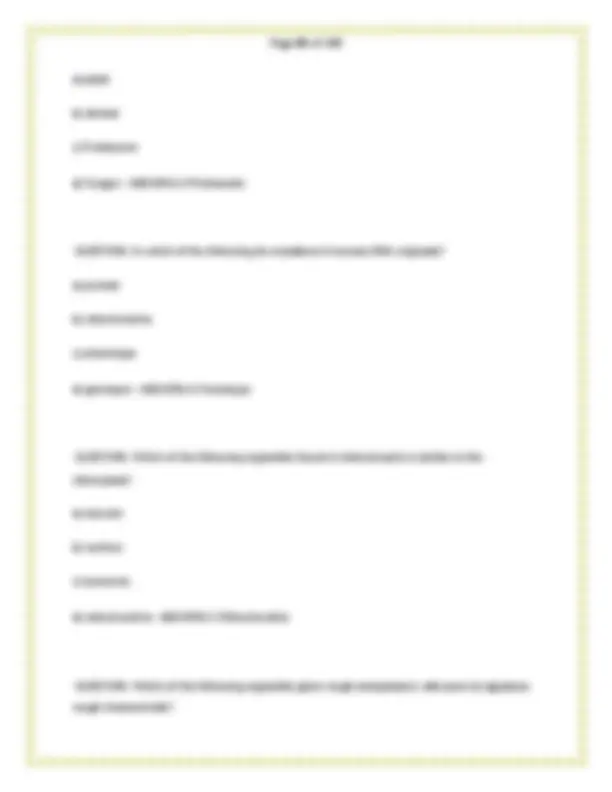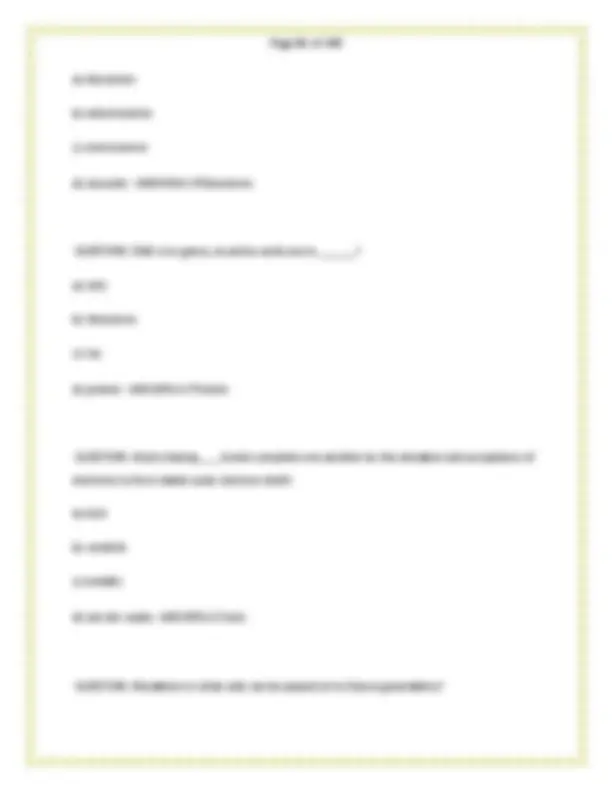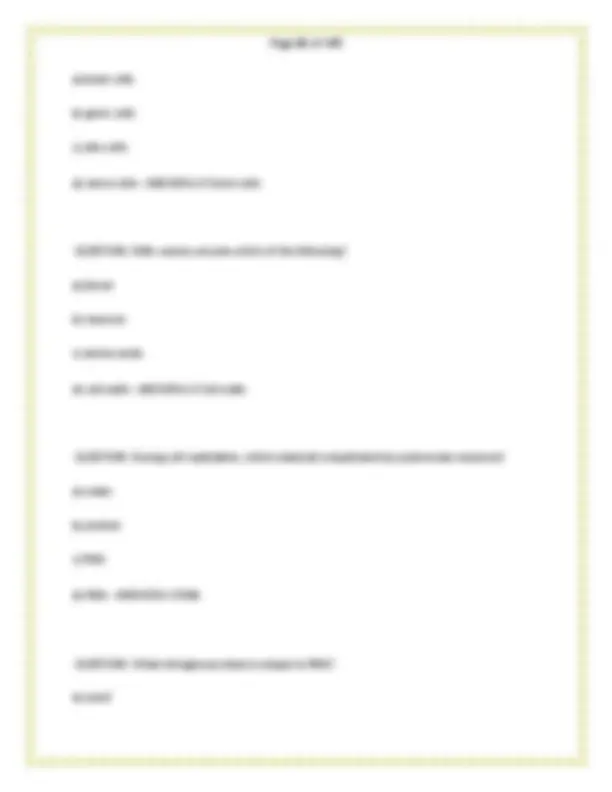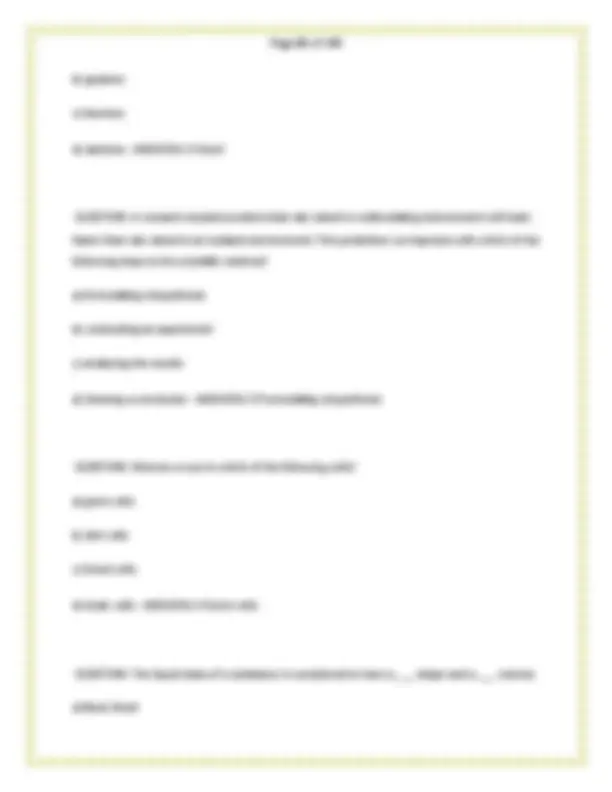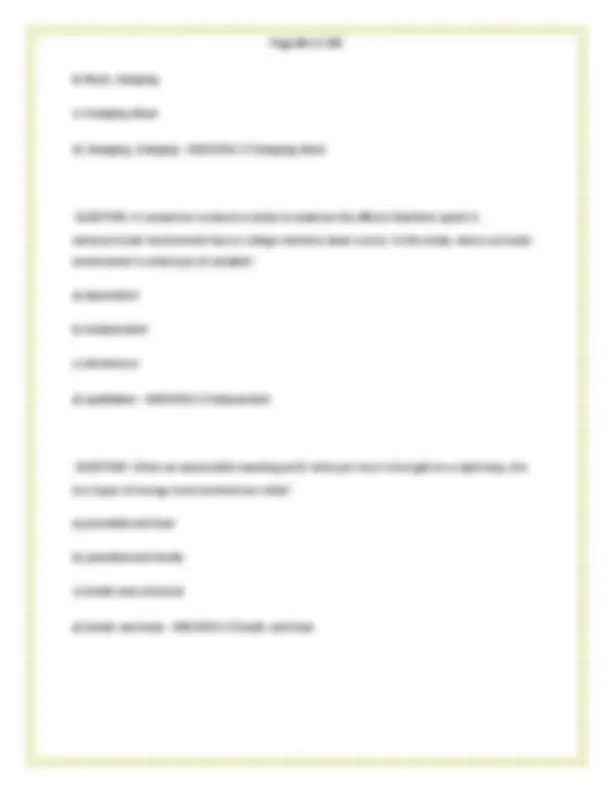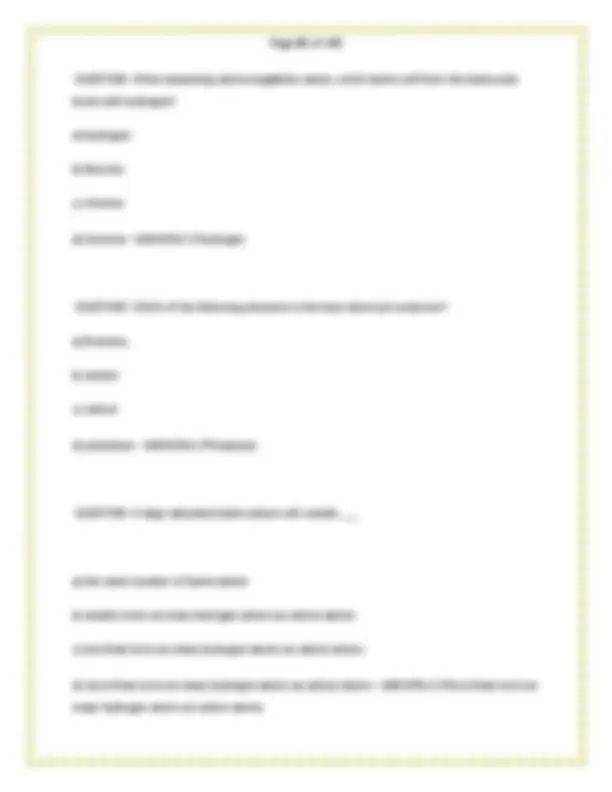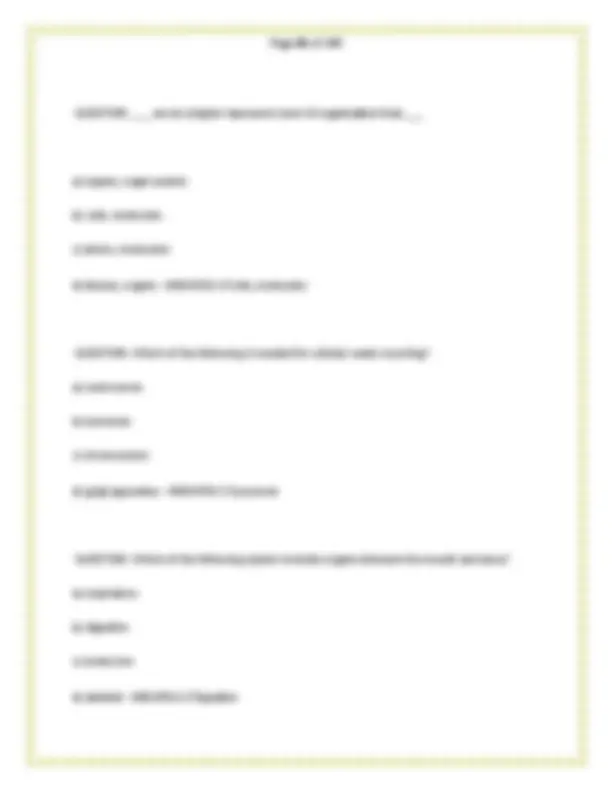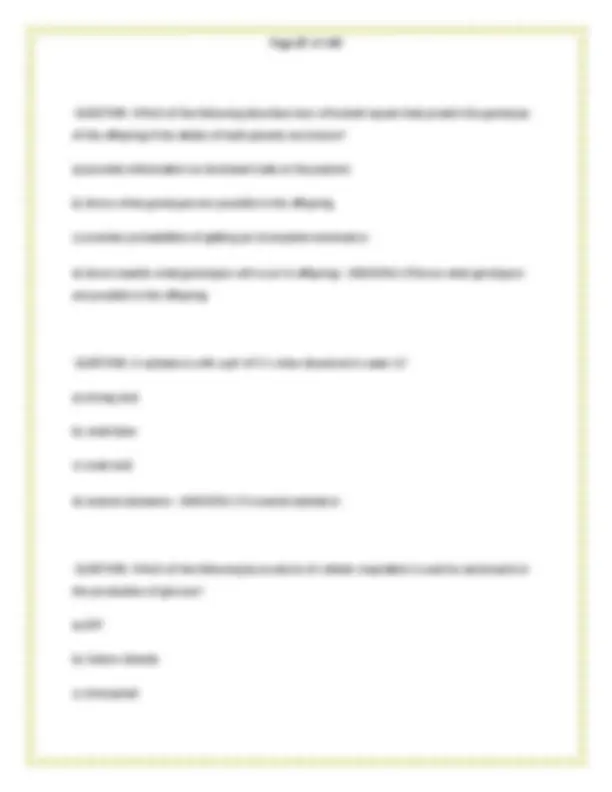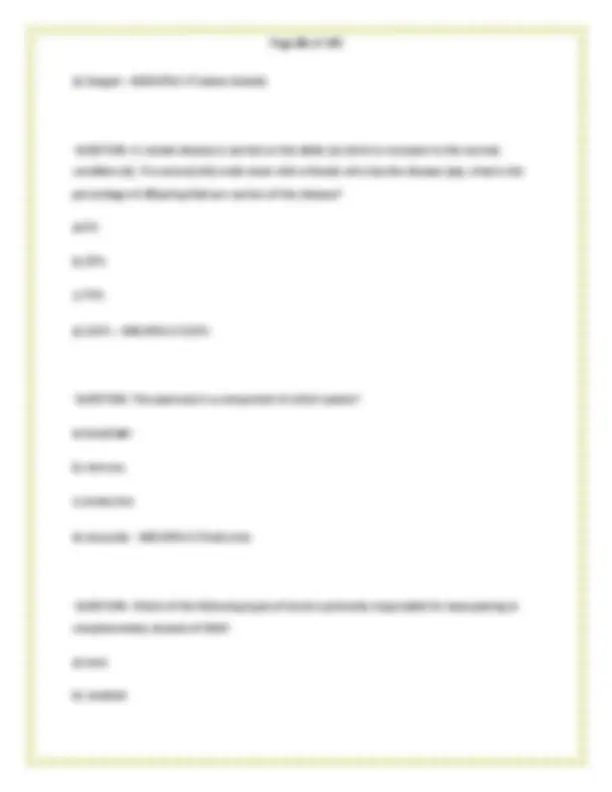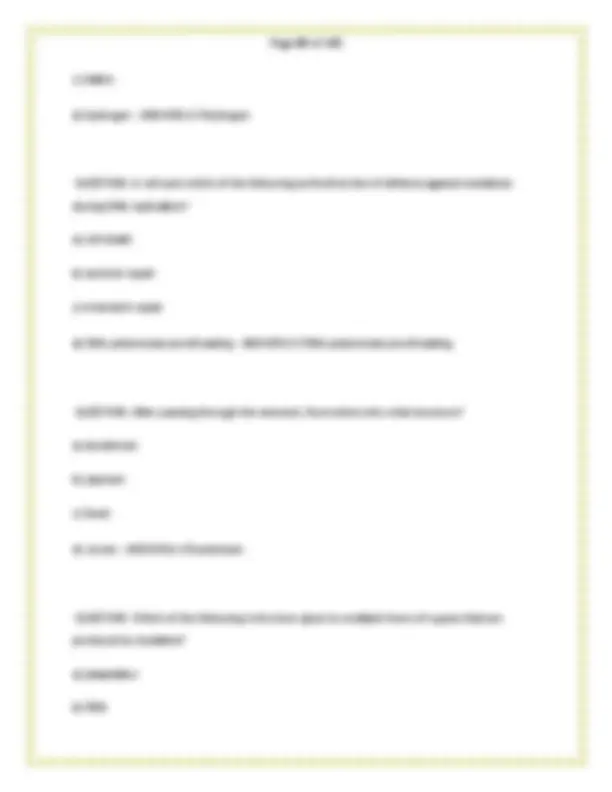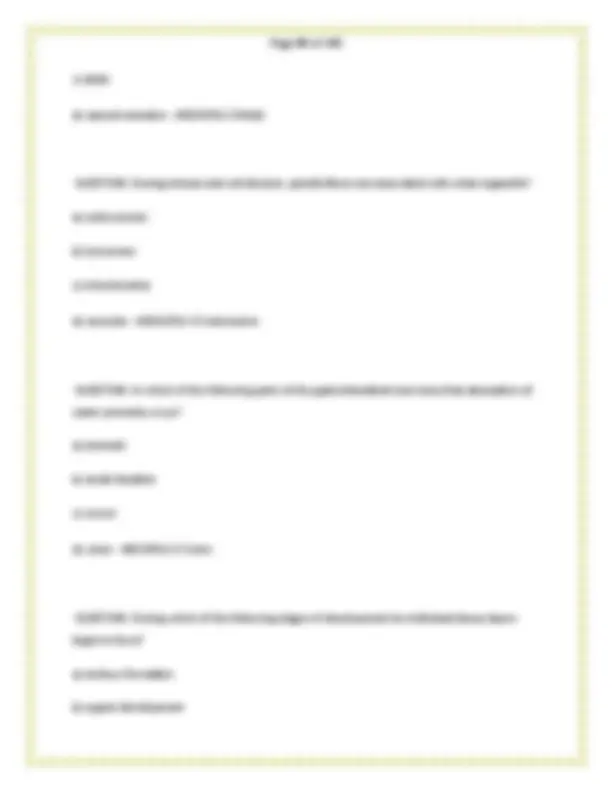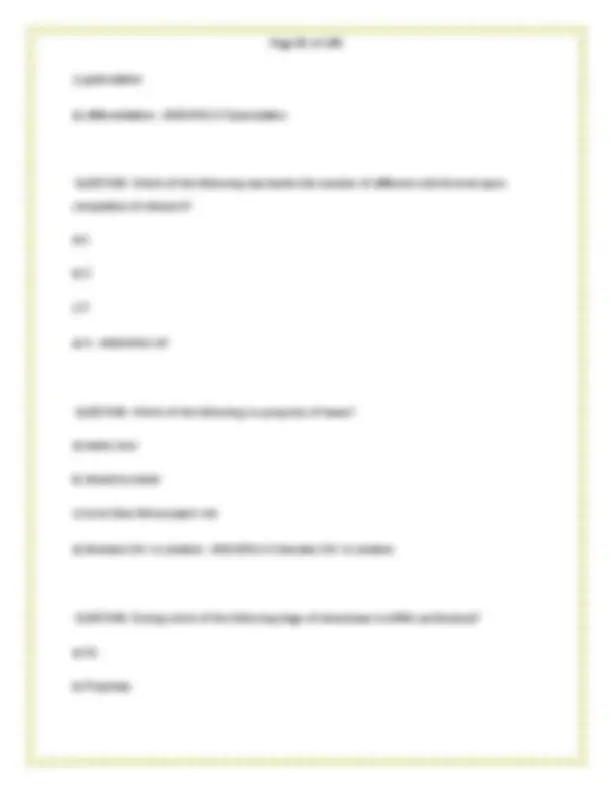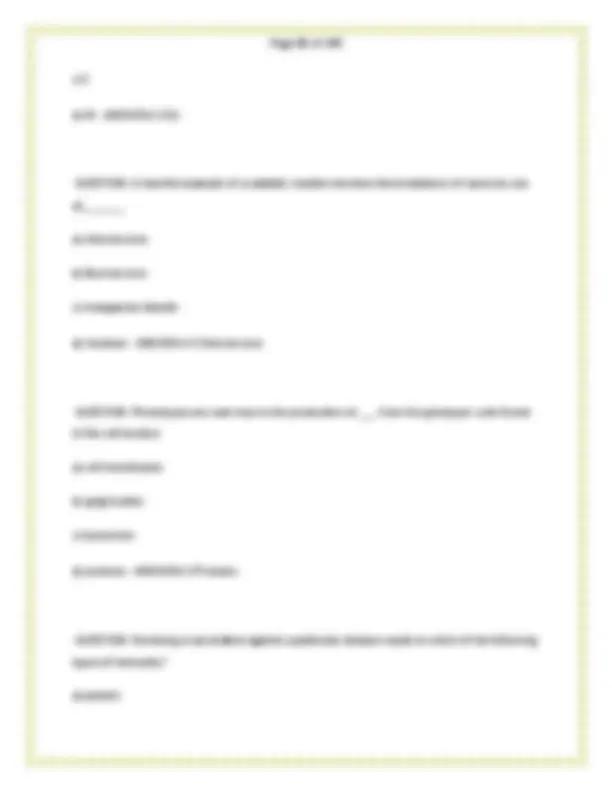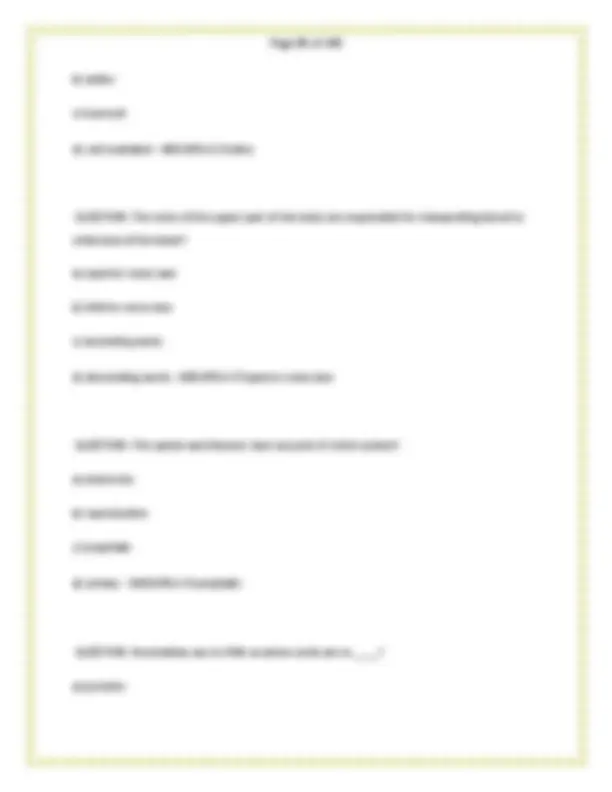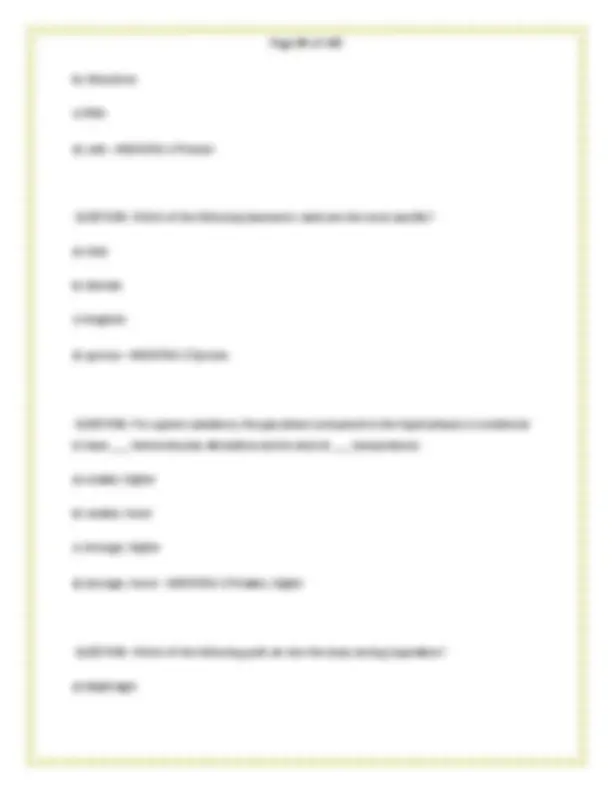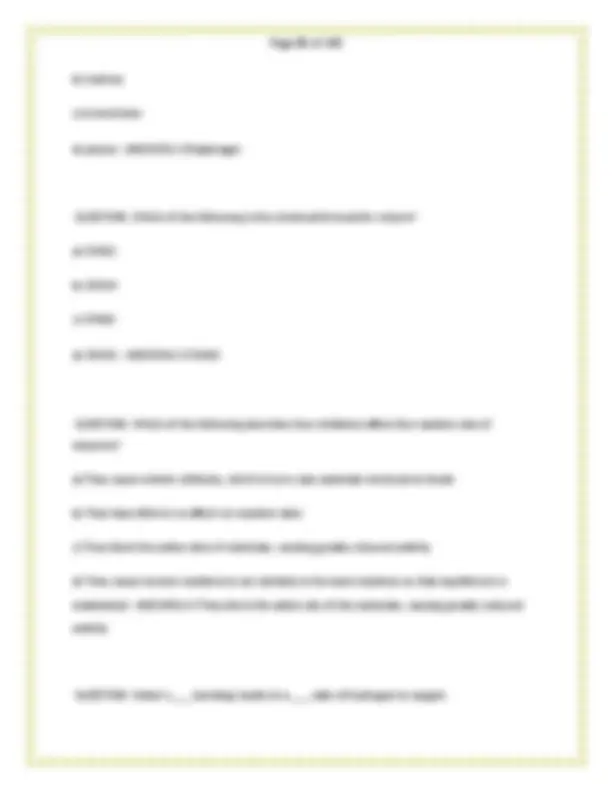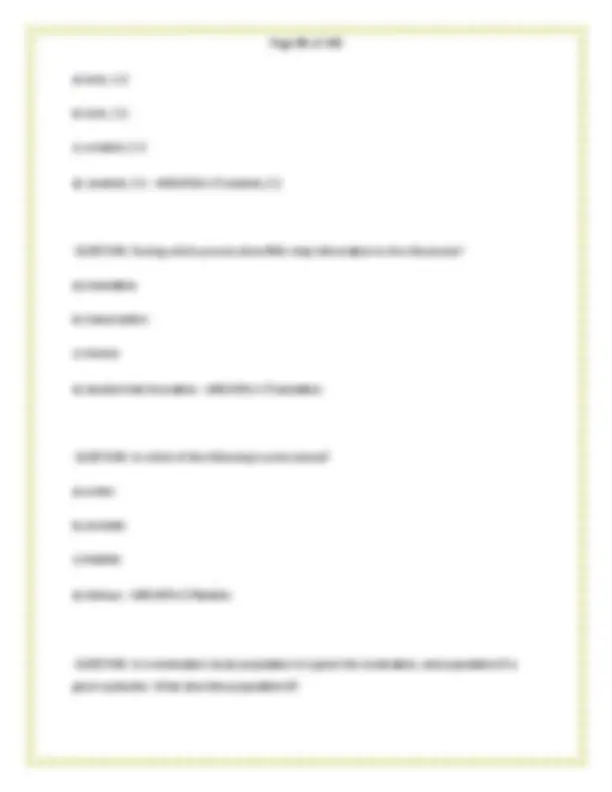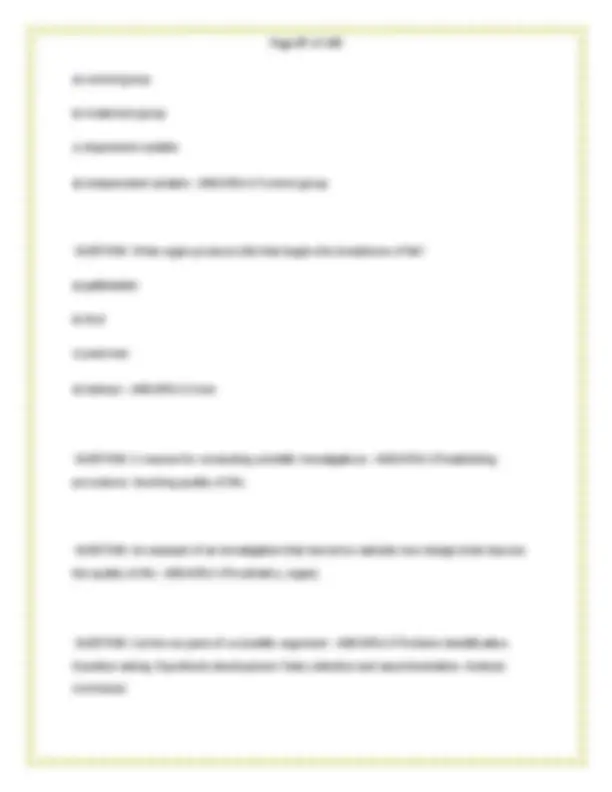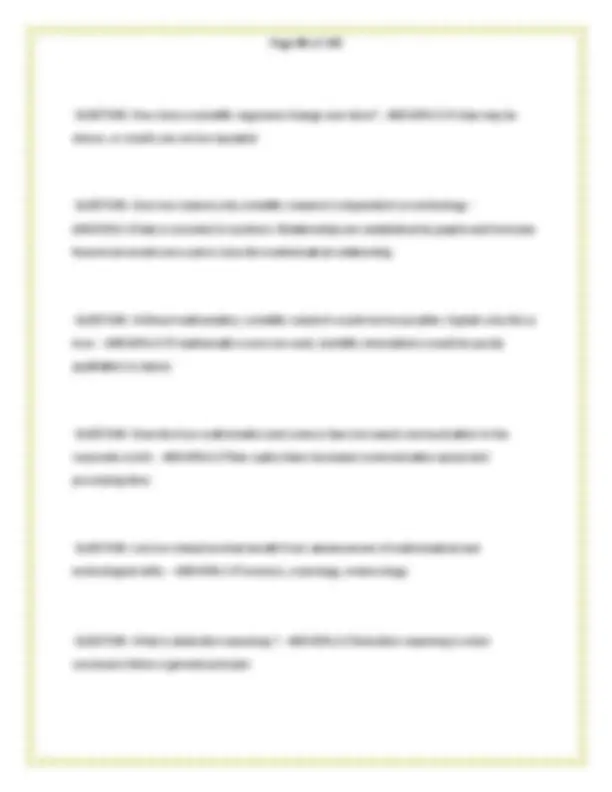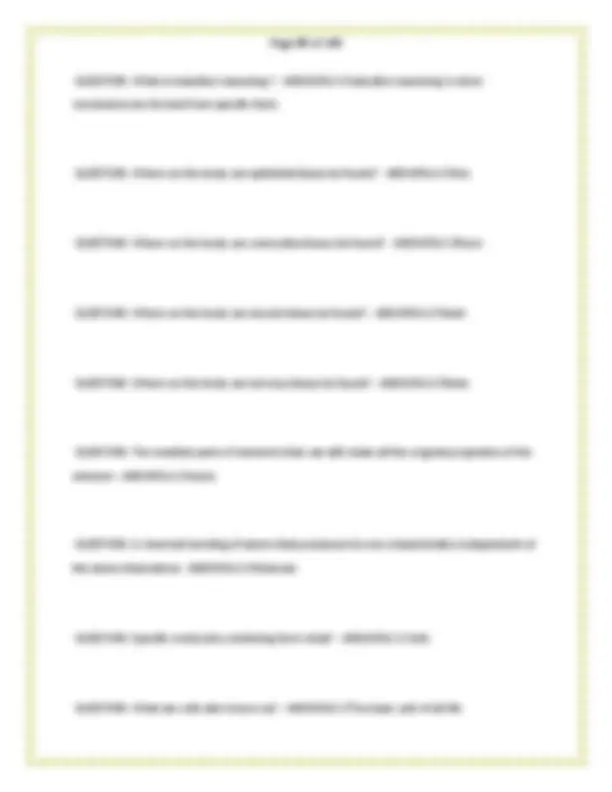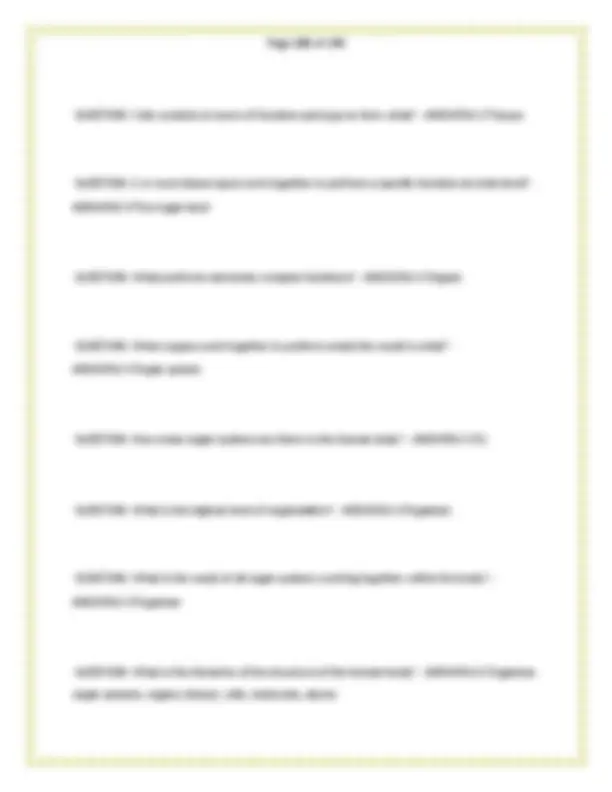Download ATI TEAS SCIENCE EXAM STUDY GUIDE LATEST VERSION THIS YEAR WITH 450 QUESTIONS AND WELL ELA and more Exams Medicine in PDF only on Docsity!
ATI TEAS SCIENCE EXAM STUDY GUIDE LATEST
VERSION THIS YEAR WITH 45 0 QUESTIONS AND
WELL ELABORATED ANSWERS WITH JUST
RELEASED
The first four steps on the scientific method are as follows: I. Identify the problem. II. Ask questions. III. Develop a hypothesis. Iv. Collect data and experiment on that data. Which of the following is the fifth step in the scientific method? A. Observe the data. B. Analyze the results. C. Measure the data. D. Develop a conclusion. B. Analyze the results.
- There are six steps in the scientific process. The results of step four must be analyzed before reaching the final step. "Develop a conclusion." Which of the following is FALSE regarding the use of qualitative and quantitative data in scientific research? A. Quantitative data is collected through numerical measurements. B. Quantitative data is more accurate than qualitative data. C. Qualitative data is focused on perspectives and behavior. D. Qualitative data is collected through observation and interviews.
B. Quantitative data is more accurate than qualitative data. The two types of measurement important in science are qualitative (When a numerical result is used) and qualitative (when descriptions or qualities are reported).
- Qualitative data is collected through observation and interviews, and focuses on the informant's behavior and perspectives. THE NEXT QUESTION REFERS TO THE FOLLOWING GRAPHICS: The chart above shows the average snowfall in inches for a two on Michigan's Upper Peninsula, during the months November through April. Which of the following can be concluded based on the information that is provided in the chart? A. April is not a good month to go skiing in the Upper Peninsula. B. Snowfall blocks the sunshine reduces the number of sunny days. C. The fewest sunny days occur in the months with the heaviest snowfall. D. There is no connection between the amount of snowfall and the number of sunny days. C. The chart shows two specific changes: snowfall levels from November to April and sunny days from November to April. Which of the following statements correctly describes the function of the corresponding physiologic structure? A. The trachea connects the throat and the stomach, encouraging food to follow this path through contractions. B. The esophagus is the cylindrical portion of the respiratory tract that joins the larynx with the lungs. C. the diaphragm is a muscle that controls the height of the thoracic cavity, decreasing the height on contraction, and increasing the height on relaxation causing expiration.
- Tendons connect the muscles to other structures of the body, typically bones. Tendons can increase and decrease in length as the bones move.
- Fat is a combination of lipids; in humans, fat forms a layer beneath the skin and on the outside of the internal organs. Two criteria for classifying epithelial tissue are: A. Cell type and cell function B. Cell shape and cell type C. Cell layers and cell shape D. Cell function and cell layers C. Cell layers and cell shape are the criteria for classifying epithelial tissue.
- Cell layers refers to the amount of cells that separate the basement membrane from the surface, such as a simple single layer, a stratified layer (2 or more), or a pseudostratfied layer.
- Cell shapes refer to the shape of the outer cells and can be squamous, columnar or cuboidal. Where is the parathyroid gland located? A. On the lateral lobes of the thyroid gland, on the posterior aspect. B. On the pyramidal lobe of the thyroid gland, on the posterior aspect. C. On the lateral thyroid gland, on the anterior aspect. D. On the left lateral lobe of the thyroid gland, on the anterior aspect. A. The parathyroid gland is located on the lateral lobes of the thyroid gland in the neck, on the posterior aspect.
- It is part of the endocrine system.
- When the supply of calcium in blood diminishes to unhealthy levels, the parathyroid gland motivates the secretion of a hormone that encourages the bones to release calcium into the
bloodstream. The parathyroid Gand also regulates the amount of phosphate in the blood by stimulating the excretion of phosphates in the urine. How many organ system are in the human body? A. 12 B. 15 C. 9 D. 11 D. There are 11 organ systems n the human body.
- Circulatory System
- Digestive System
- Endocrine System
- Integumentary System
- Lymphatic System
- Muscular System
- Nervous System
- Reproductive System
- Respiratory System
- Skeletal System
- Urinary System Which element or structure within the respiratory system is responsible for removing foreign matter from the lungs? A. Bronchial tubes
- Atoms Muscles are types of tissues, so muscles do not have a separate place in the hierarchy but instead fall within the types of tissues. THE NEXT TWO QUESTIONS ARE BASED ON THE PERIODIC TABLE On average, how many neutrons does one atom of bromine(Br) have? Atomic # - 35 Atomic mass - 79. A. 35 B. 44. C. 45 D. 79. B. 44. 79.9-35 = 44. On average, how many protons does one atom of zinc (Zn) have? Atomic # - 30 Atomic mass - 65. A. 30 B. 35 C. 35.
D. 65.
A. 30
The number of protons is the same for every atom of a given element and is the elements's atomic number; in this case 30 for Zinc (Zn). Which statement below correctly describes the movement of molecules in the body and/or in relation to the external environment? A. Osmosis is the movement of a solution from and area of low solute concentration to an area of high solute concentration. B. Diffusion is the process in the lungs by which oxygen is transported from the air to the blood. C. Dissipation is the transport of molecules across a semipermeable membrane from an area of low concentration to high concentration, requiring energy. D. Reverse osmosis is the movement of molecules in a solution from an area of high concentration to an area of lower concentration. B. In the lungs, oxygen is transported from the air to the blood through the process of diffusion. In which molecules passively move from an area of high concentration to low concentration. Specifically, the alveolar membranes withdraw the oxygen form the air in the lungs into the bloodstream.
- Osmosis is the passive movement of a water from an area of low solute concentration to an area of higher solute concentration through a permeable membrane.
- Reverse osmosis is the active transport of water opposite the concentration gradient from an area of low solute concentration to high solute concentration.
- Dissipation is a more general reference of the spread or loss of energy. Which gland is responsible for the regulation of calcium levels? A. the parathyroid glands
- The jejunum is the second portion of the small intestine in which amino acids, fatty acids, and sugars are absorbed. In your garden, you noticed that the tomato plants did better on the north side of your house than the west side and you decided to figure out why. They are both planted with the same soil that provides adequate nutrients to the plant, and they are watered at the same time during the week. Over the course of a week, you begin to measure the amount of sunlight that hits each side of the house and determine that the north side gets more light because the sunlight is blocked by the house's shadow on the west side. What is the name of the factor in your observations that affected the tomato plants growth? A. the control B. the independent variable C. the dependent variable D. The conclusion B. The conclusion was that the amount of sunlight received by the pants was affecting their growth.
- The independent variable was the amount of light that was given to the plants and could have been manipulated by the experiment by moving the plants or adding equal parts of light.
- No control was used in this experiment. Which of the following describes one responsibility of the integumentary system? A. Distributing vital substances (such as nutrients) throughout the body B. Blocking pathogens that cause disease C. Sending leaked fluids from cardiovascular system back to the blood vessels D. sorting bodily hormones that influence gender traits.
B. The integumentary system includes skin, hair, and mucous membranes, all of which are responsible-in part, at least-for blocking disease-causing pathogens from entering the bloodstream.
- The circulatory system distributes vital substances through the body.
- The lymphatic system sends leaked fluids from the cardiovascular system back to the blood vessels.
- The reproductive system stores bodily hormones that influence gender traits. When are the parasympathetic nerves active within the nervous system? A. when an individual experiences a strong emotion, such as fear or excitement. B. when an individual feels pain or heat. C. when an individual is either talking or walking. D. when an individual is either resting or eating. D. The parasympathetic nerves are active when an individual is ether resting or eating.
- The sympathetic nerves are active when an individual experience a strong emotion, such as fear or excitement.
- Feeling pain and hat fall under the responsibility of the sensory neurons. Talking and walking fall under the responsibility of the ganglia within the sensory-somatic nervous system. Which of the following best described the relationship between the circulatory system and the integumentary system? A. removal of excess heat from body. B. hormonal influence on blood pressure C. regulation of blood's pressure and volume. D. development of blood cells within marrow.
B. bladder. C. liver D. sweat glands D. Blood is cooled as it passes through capillaries surround the sweat glands. Heat is absorbed along with excess salt and water and transferred to the glands as sweat. Droplets of sweat then evaporate from the skin surface to dissipate heat and cool the body
- The kidney, bladder, and liver are NOT involved in regulating body temperature. A part of which body system controls fluid loss, protects deep tissues, and synthesizes vitamins D? A. the skeletal system B. the muscular system C. the lymphatic system D. The integumentary system D. The skin is a part of the integumentary system, along with the heart, nails, nerves, and glands. The skin controls fluid loss, protects deep tissues, and synthesizes vitamin D.
- The skeletal system gives the body its bony supporting structure, protects vital organs, collaborates with muscles in body movement, stores calcium, and produces red blood cells.
- The muscular system maintains posture, collaborates with the bones in the body movements, uses energy, and generates heat.
- The lymphatic system retrieves fluids leaked from capillaries and contains white blood cells, and part of it support parts of the immune system. There are three insects that are being compared under a microscope. As a scientist, you decide that measuring them would be an important part of recording their data. which unit of measurement would best for this situation?
A. centimeters B. meters C. micrometers D. kilometers C. micrometers The best use of the International System of Units (SI) for this situation would be the use of the micrometer as it is the smaller unit of measurement provided and the scientist is using a microscope to view the insects. The respiratory system _____ oxygen and _____ carbon dioxide. A. inhale; exhale B. delivers; expels C. creates; absorbs D. exhales; inhale B. delivers; expels
- Our respiratory system inhales air, of which oxygen is one component. From that inhaled air, the reparatory system delivers oxygen to the body. Though gas exchange, it then expels carbon dioxide (CO2) from the body as we exhale.
- The respiratory system obtains oxygen from the air we inhale; it does not create it, and it expels CO2 rather than absorbing it. We do not use our rxepiratyroy systems to exhale oxygen or inhale CO2. Which statement below accurately describes the function of its element? A. collagen is a spongy fatty compound that creates a padding between bones and other structures. B. hemoglobin is the amount of red blood cells that are present in blood, which can reflect disease states, hydration, and blood loss. C. lymph is tissue that forms into nodes through which blood is filtered and cleaned. D. an antigen stimulates the production of antibodies.
it takes the ball to make on complete period. A period is defined as the time it takes the ball to swing forward and back again to its starting positions. That is repeated using different string lengths. Lengthening the string of the pendulum increases the time it takes the ball to make on complete period. What correction would you have the student make to the hypothesis? A. Turn it into an "if/then" statement. B. Add the word "will" in the middle after the word "pendulum. C. Switch the order of the sentence so that the phrase about the period comes first, and the phrase about the string's length is last. D. No corrects are needed. A. Turn it into an "if/then" statement. A formalized hypothesis written int he form of an if/then statement can be tested. A statement may make a prediction or imply a cause/effect relationship, but that does not necessarily make it a good hypothesis. THE NEXT TWO QUESTIONS ARE BASED ON THE FOLLOWING INFORMATION. A student is conducting an experiment using a ball that is attached to the end of a string on a pendulum. The student pulls the ball back so that it is at an angle to its resting position. As the student releases the ball, it swings forward and backward. The student measures the time it takes the ball to make on complete period. A period is defined as the time it takes the ball to swing forward and back again to its starting positions. That is repeated using different string lengths. What would be an appropriate control variable for this experiment? A. the period B. the length of the string
C. the mass of the ball D. the color of the ball C. The mass of the ball. The mass of the ball is appropriately called a control variable for the experiment. A control or controlled variable is a factor that could be varied, but for testing purpled should remain the same throughout all experiences, otherwise, it could affect the results. Which of the following does not exist in RNA? A. uracil B. thymine C. cytosine D. guanine B. The substance thyme does not exist in RNA. The bases of RNA include uracil, cytosine, guanine, and adenine. In which of the following muscle types are the filaments arranged in a disorderly manner? A. cardiac B. smooth C. skeletal D. rough B. Smooth muscle tissue is said to be arranged in a disorderly fashion because it is not striated like the other two types of muscle: cardiac and skeletal. Striations are line that can only be seen with a microscope.
- Smooth muscle is typically found in the supporting tissues of hollow organs and blood vessels.
- Cardiac muscle is found exclusively in the heart; it is responsible for the contractions that pump blood throughout the body.
- Skeletal muscle, by far the most preponderant in the body, controls the movements of the
- The frontal or coral plane refers to ta cut that divides the body into anterior and posterior sections
- The oblique plane is when a cylindrical organ is sectioned with an angular cut across the organ. In the development of genetic traits, one gene must match to one _______ for the traits to develop correctly. A. codon B. protein C. amino acids D. chromosomes B. In the development of genetic traits, one gene must match to a portion for a genetic trait to develop correctly. Which of the following is not composed of striated muscle? A. quadriceps B. uterus C. triceps D. gastrocnemius B. Uterus. Skeletal or striated muscles are voluntary muscles that help support the skeletal structures. Example of striated muscles are the biceps, triceps, quadriceps, gluteus, and gastrocnemius muscles to name a few. Smooth or involuntary muscles are muscles primarily found in the visceral organs such as the intestines, prostate, reproductive organs, bladder and trachea. Which of the following is NOT found in the dorsal cavity of the body? A. cerebellum B. heart
C. brainstem D spine B. Heart The vertebral cavity (containing the spine) can be found in the dorsal cavity along with the cranial cavity (containing the brain). The ventral body cavity is divided into several subsections; the thoracic and abdominopelvic cavities.
- The heart is int he thoracic cavity, the stomach is int he abdominal cavity, and the testes are the pelvic cavity. Which of the following best describes the careful ordering of molecules within solids that have a fixed shape? A. physical bonding B. par molecules C. metalloid structure D. crystalline order D. Crystalline order Solids with a fixed shape have crystalline order that defines and maintains that shape. Which of the following statement properly describes how the structure moves during inspiration? A. the lungs contract on inspiration B. the diaphragm moves downward on inspiration C. the ribs remain fixed during inspiration D. the heart moves inward on inspiration B. The diaphragm moves downward or contracts to increase the space in the thoracic cavity.
- This downward motion inflates the lungs and contrast the ribs.
- The heart's position does not change during inspiration or expiration.

